
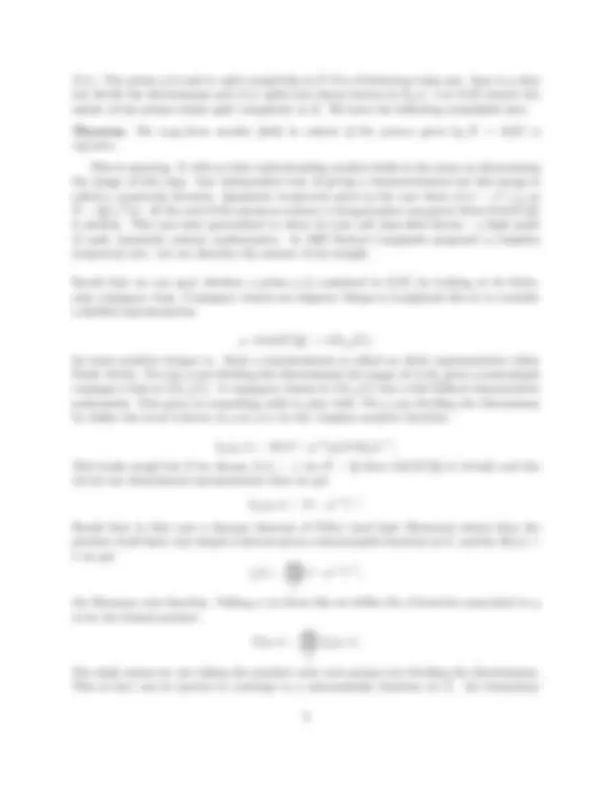

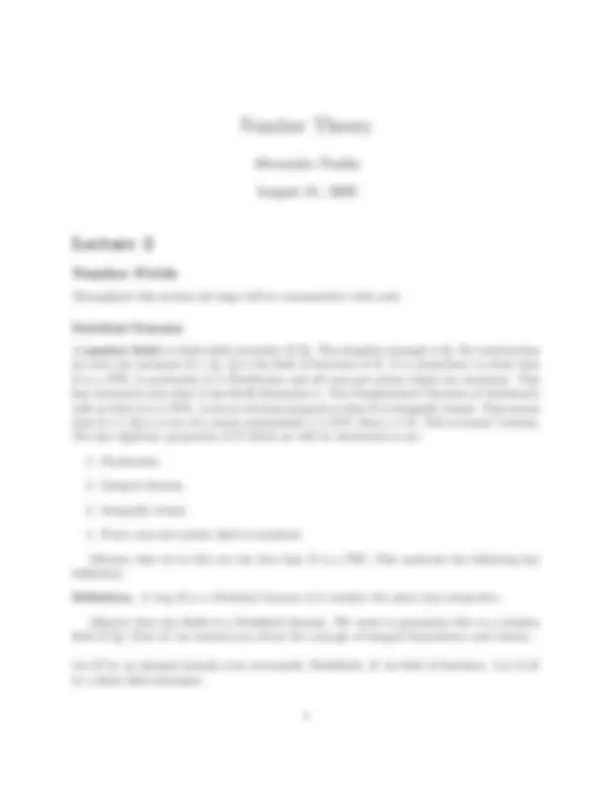
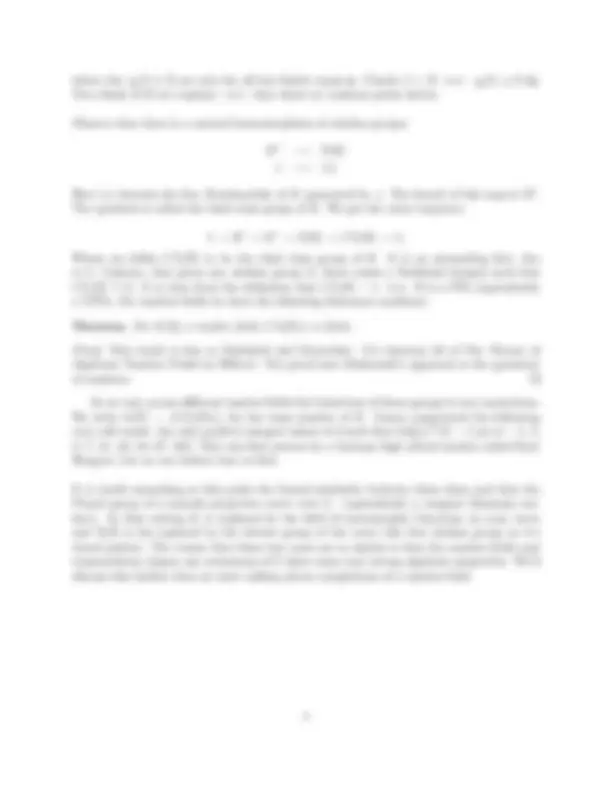
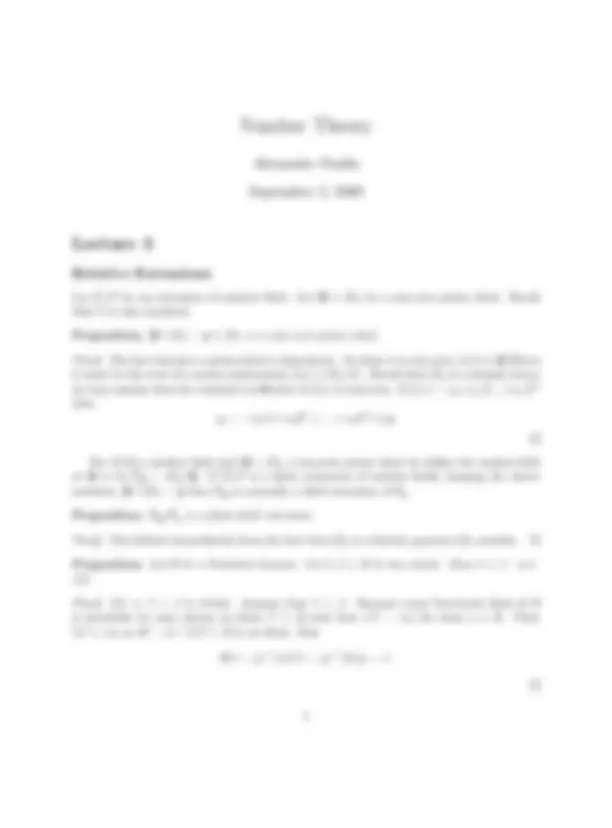
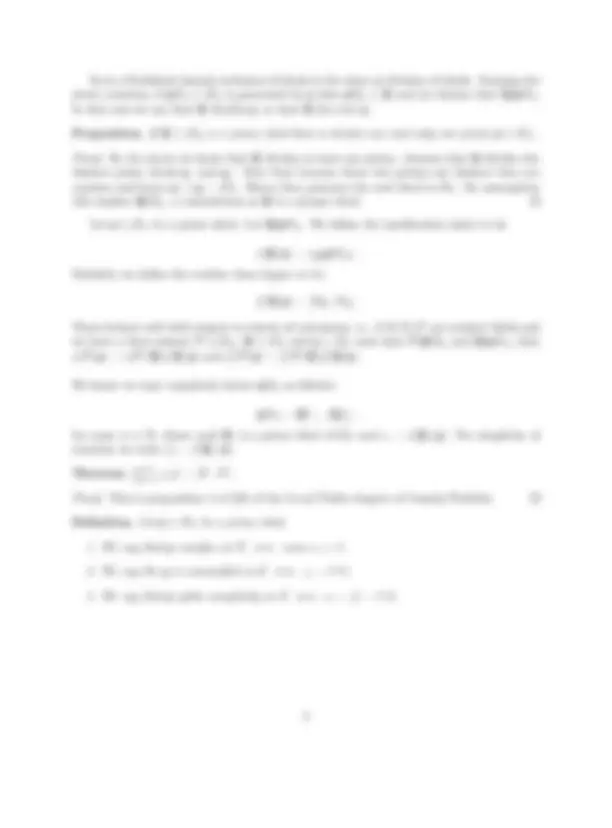

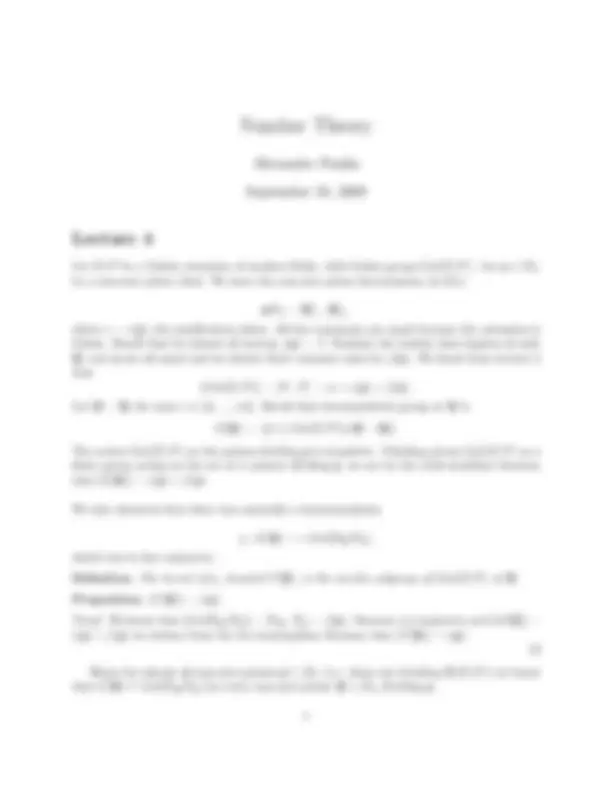
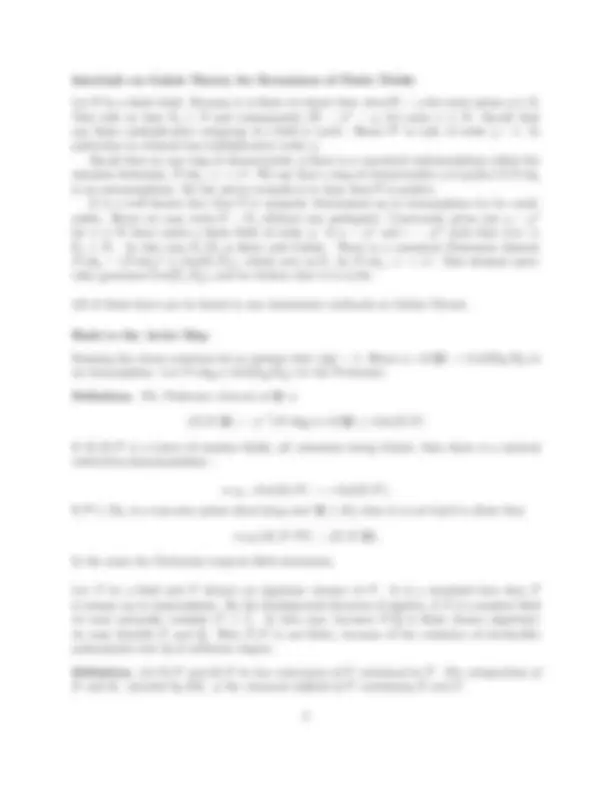
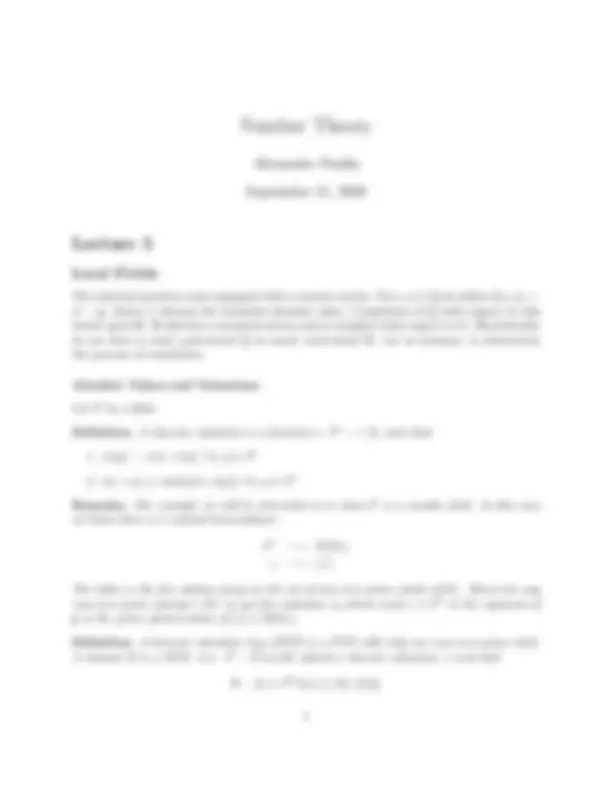
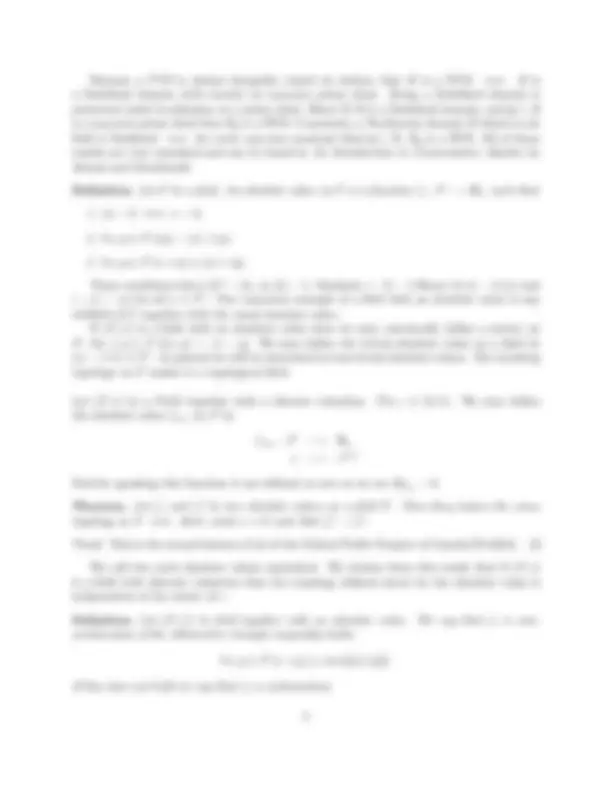
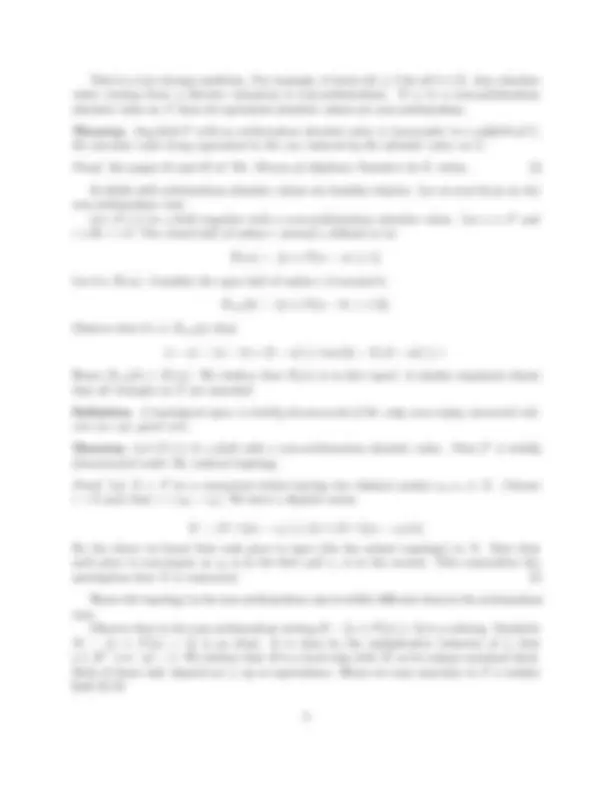
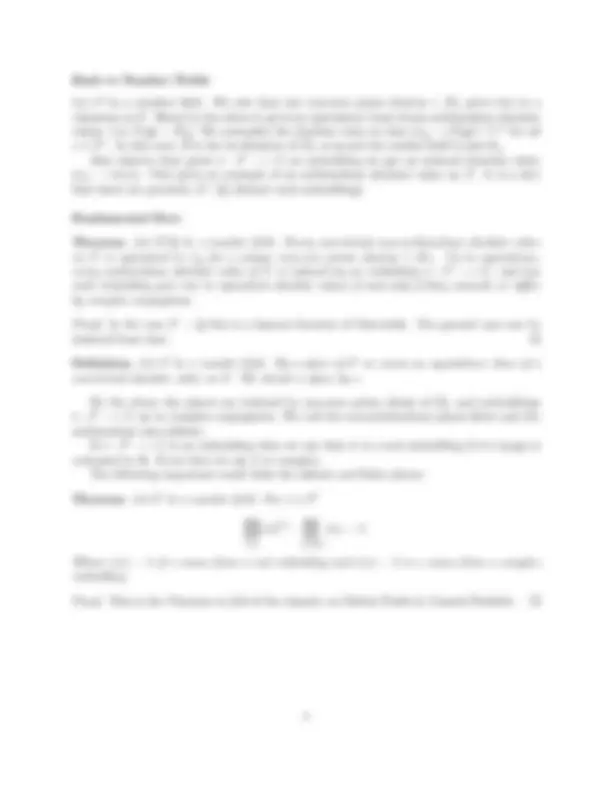
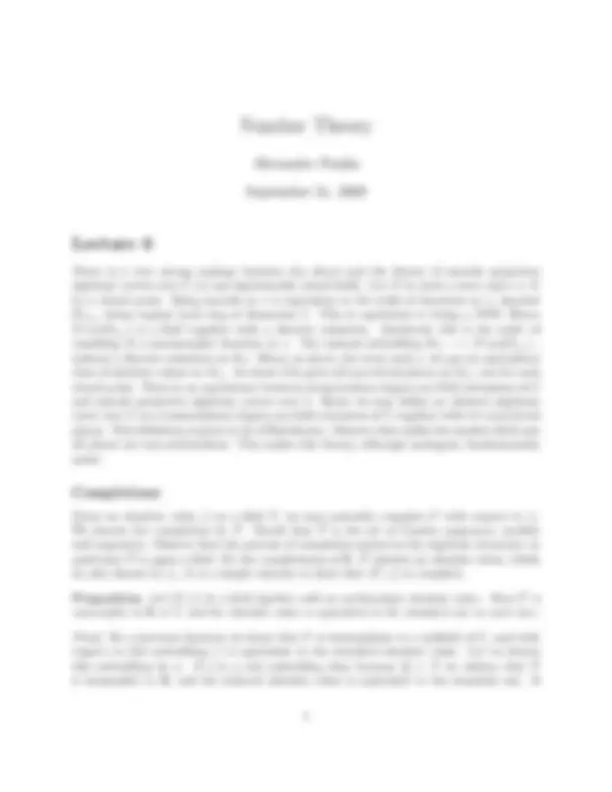
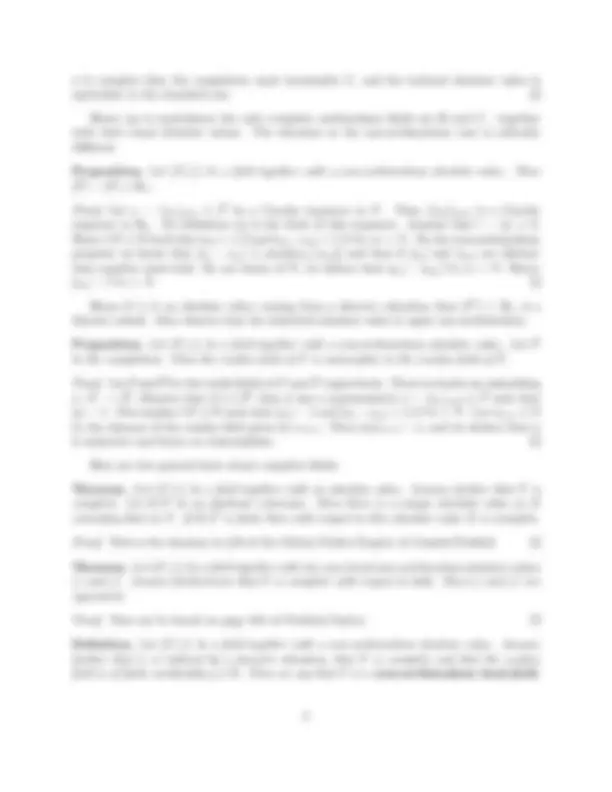
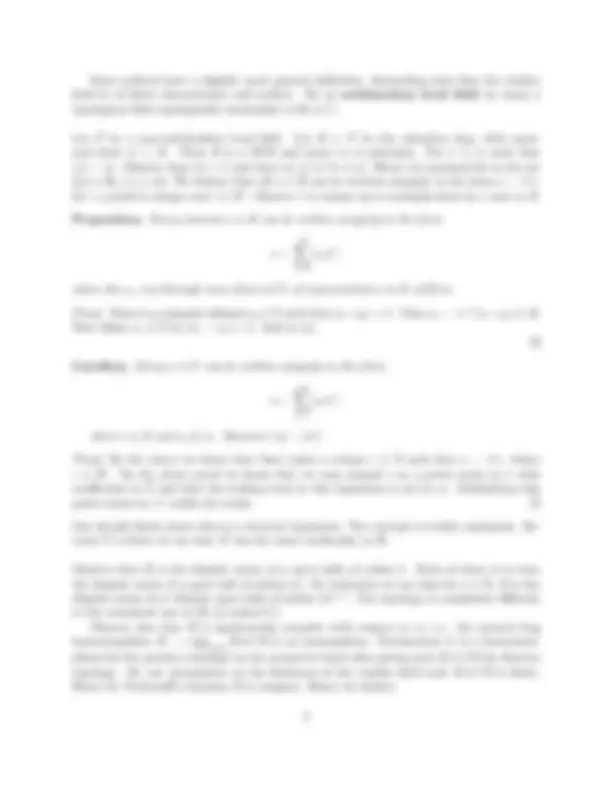
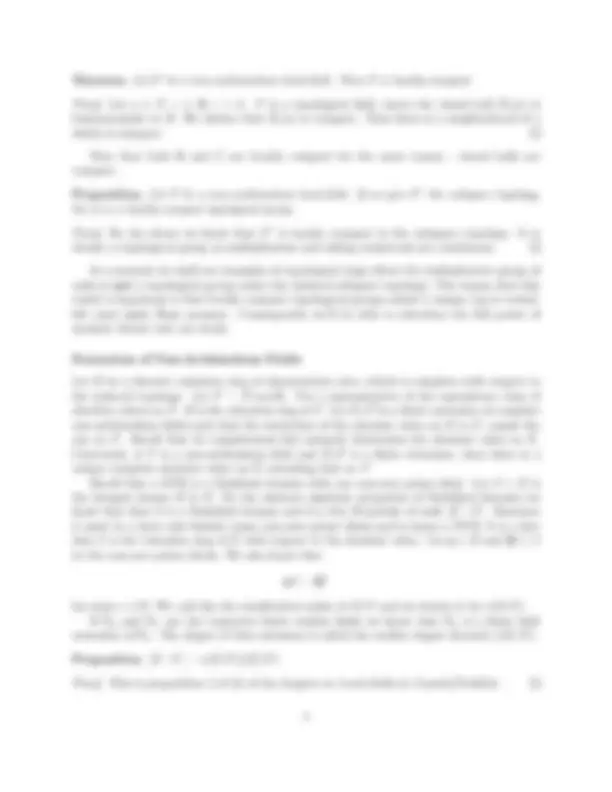
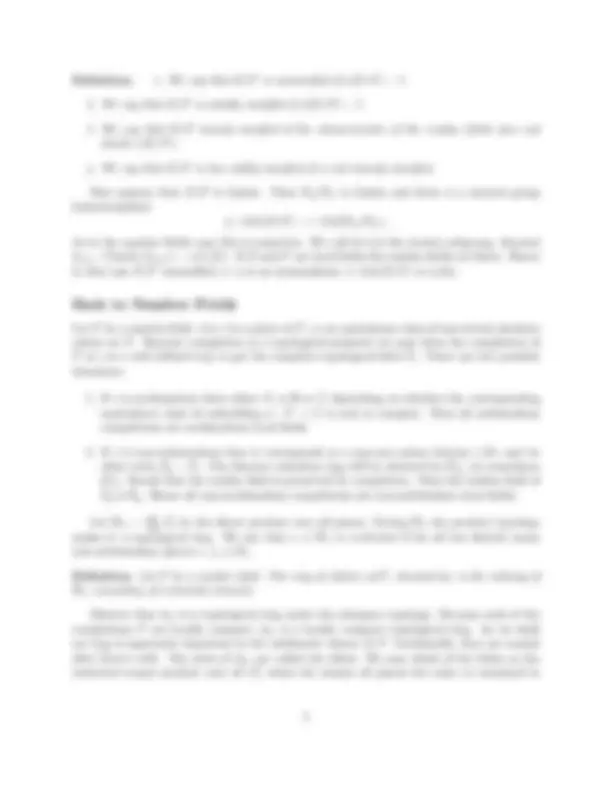
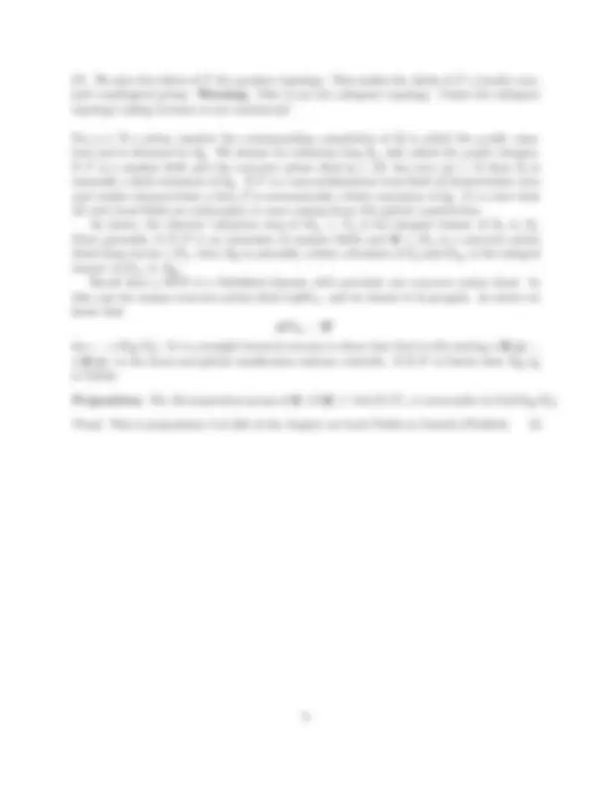
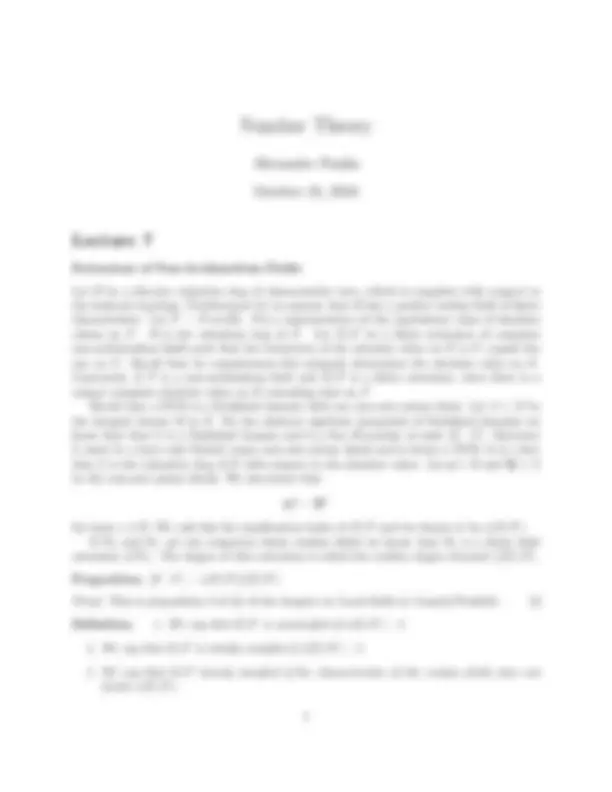
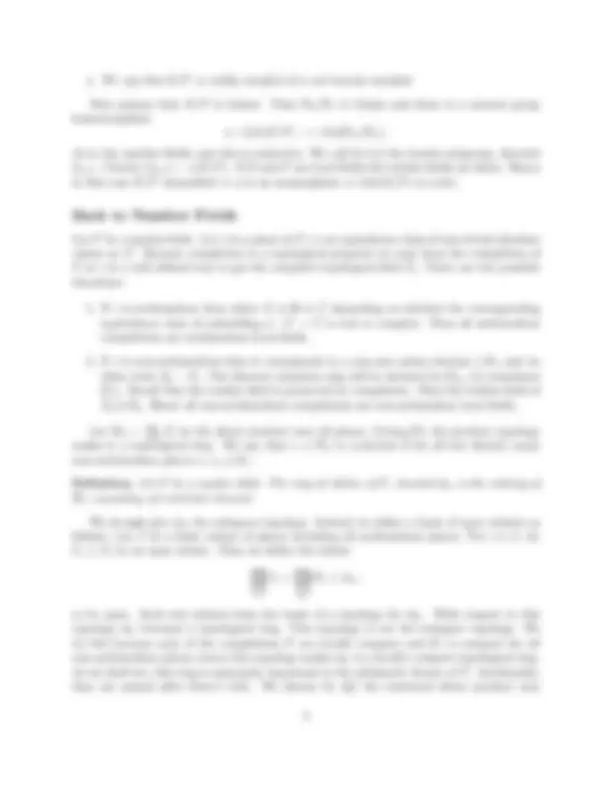
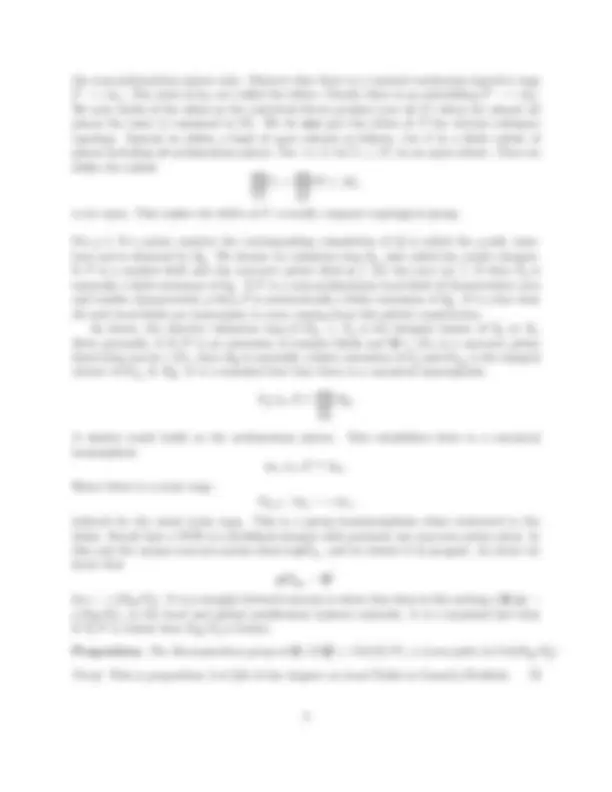
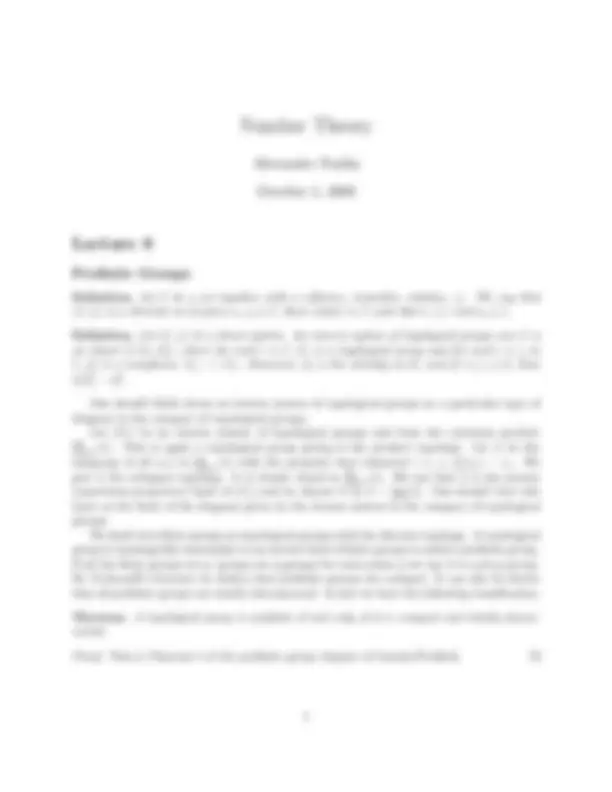
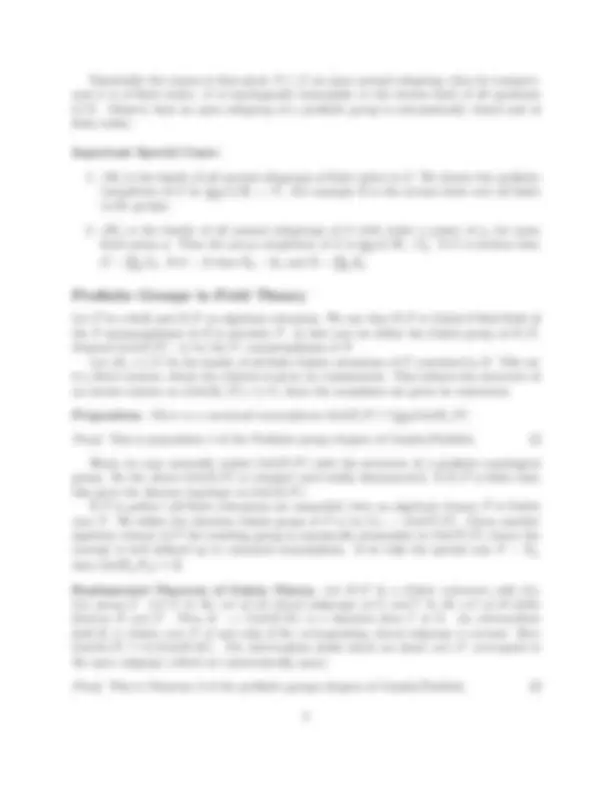
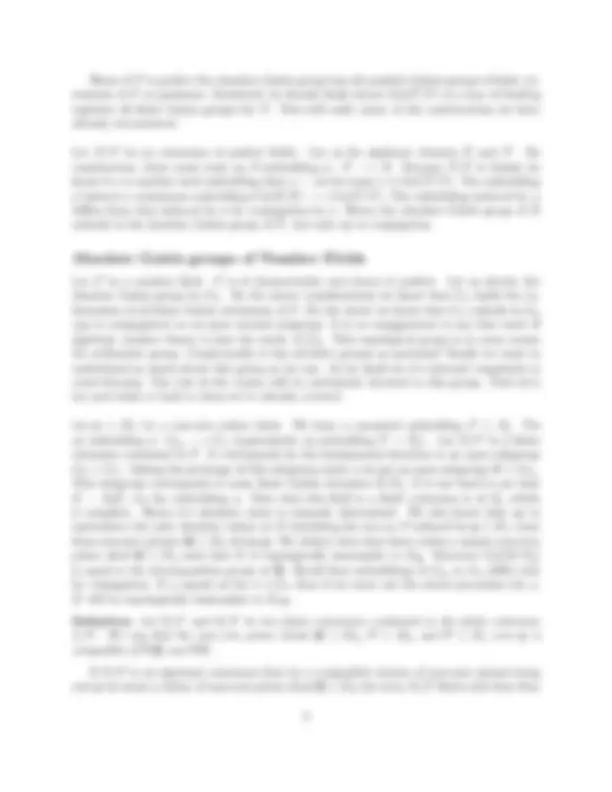
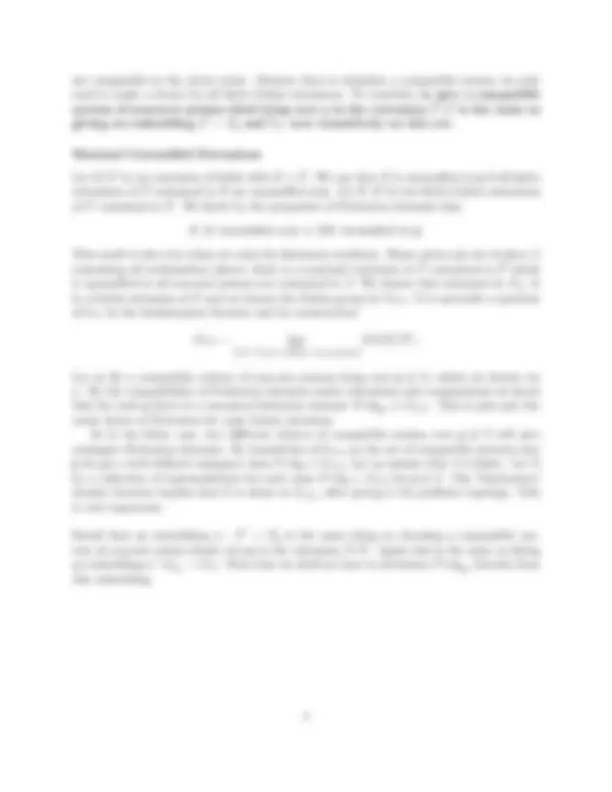
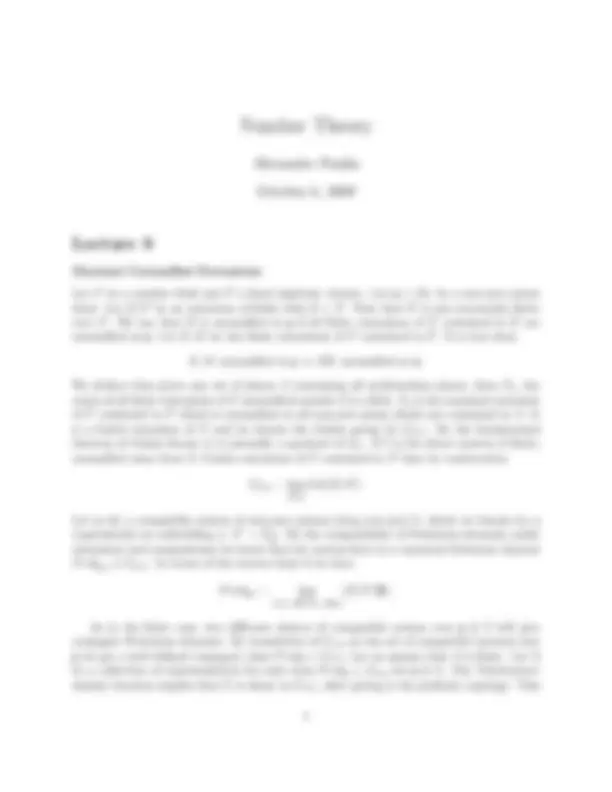
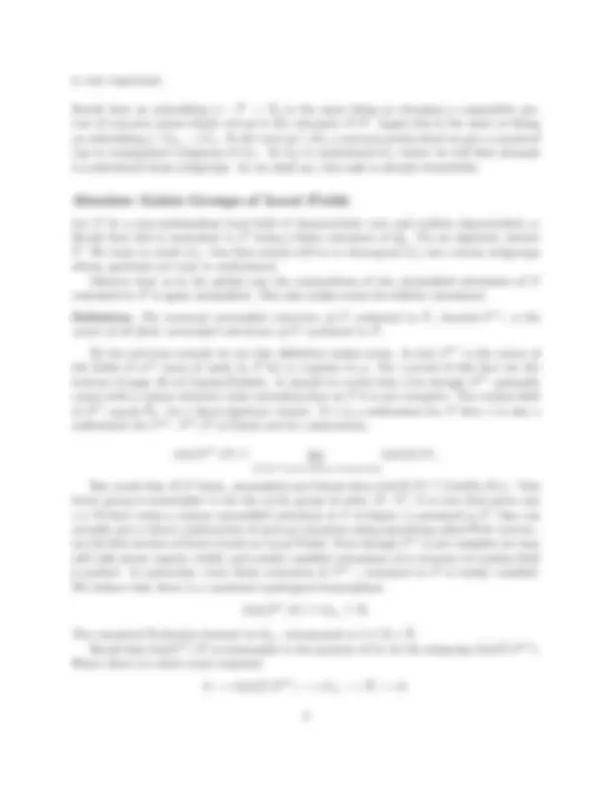
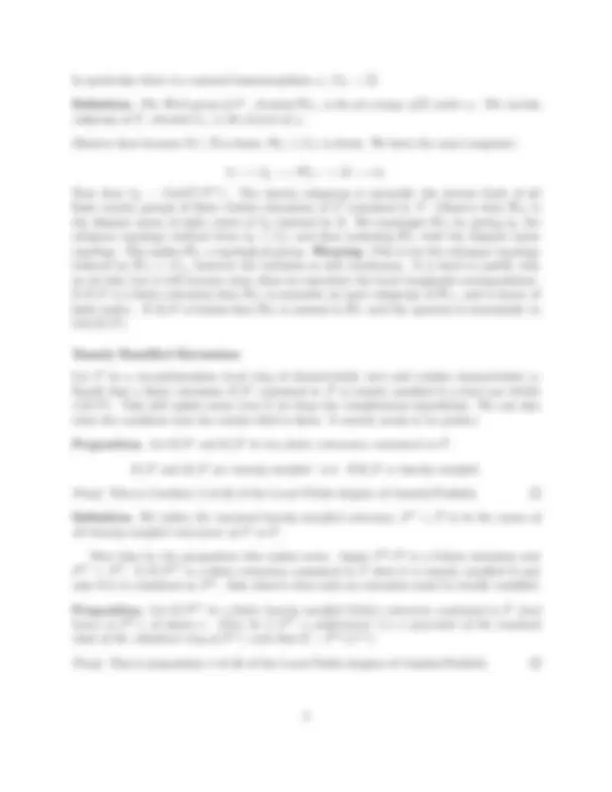
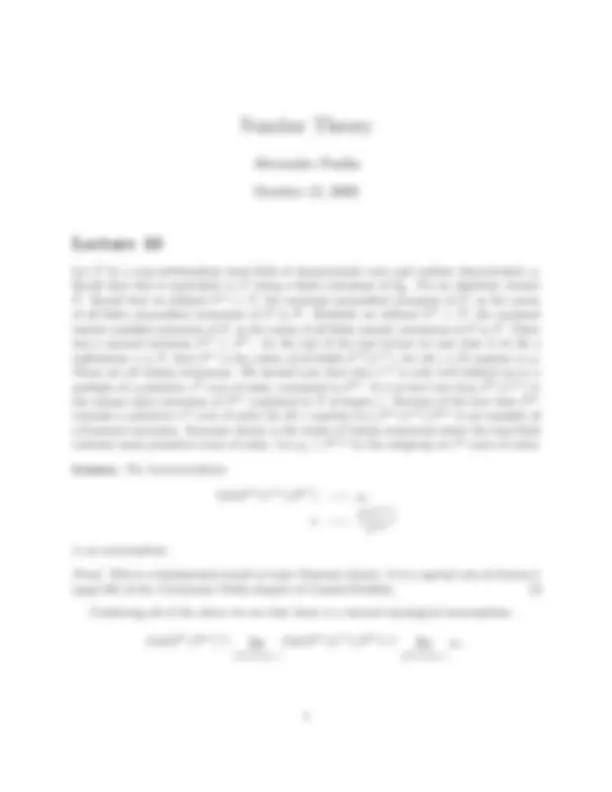
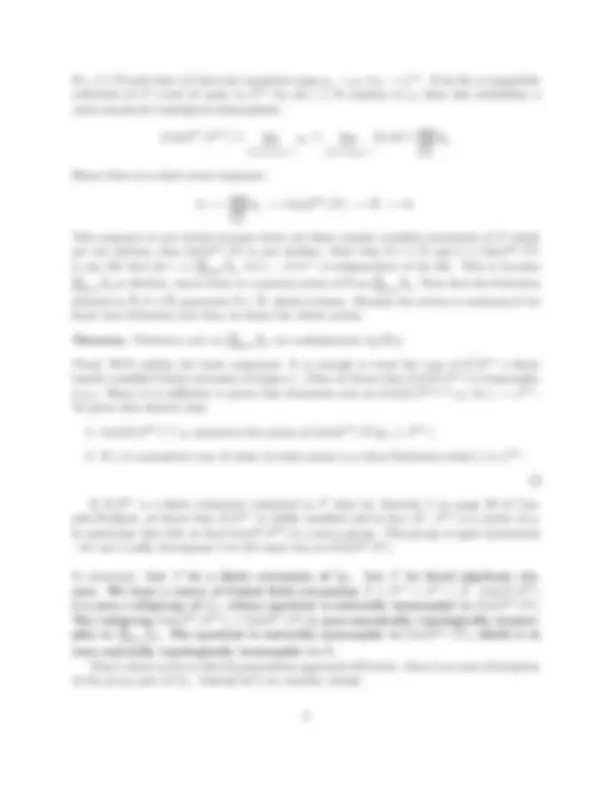
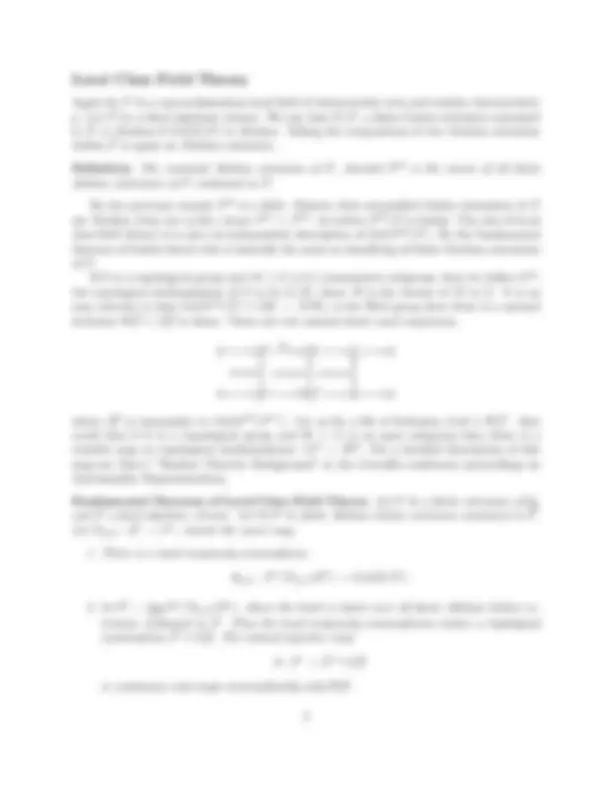
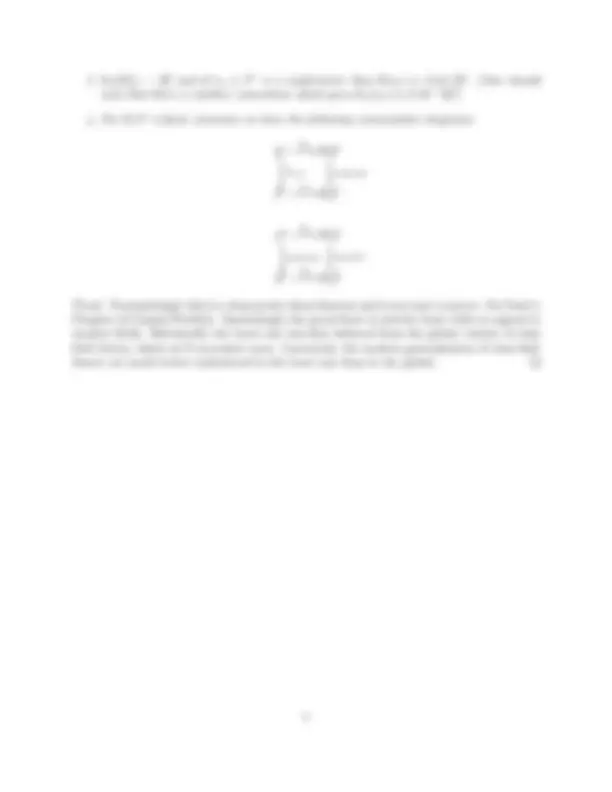
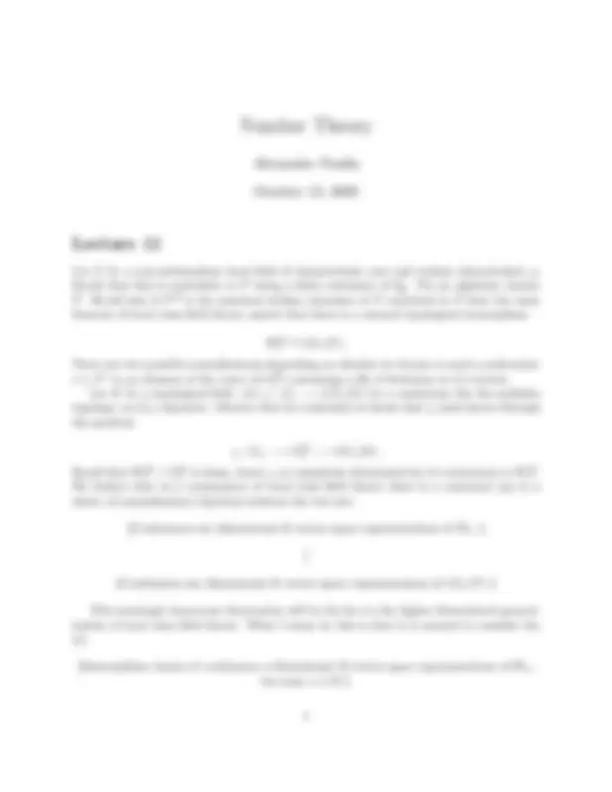
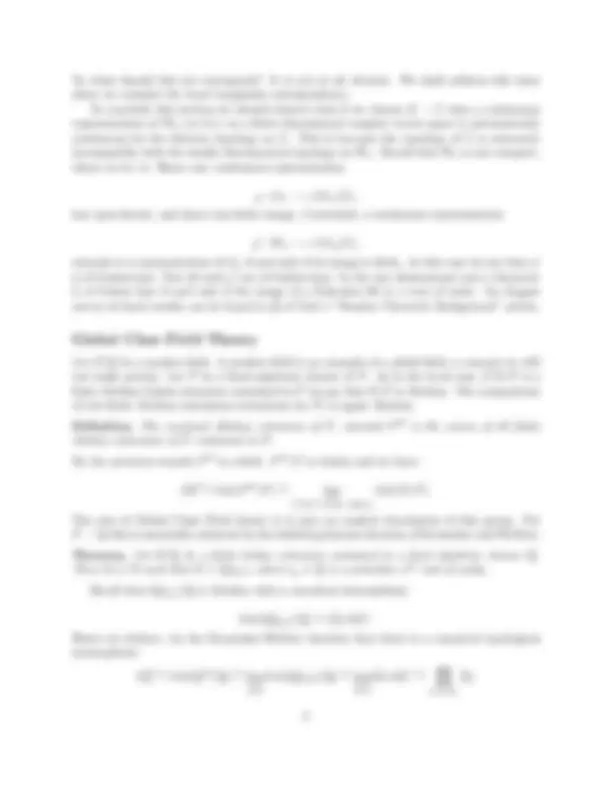
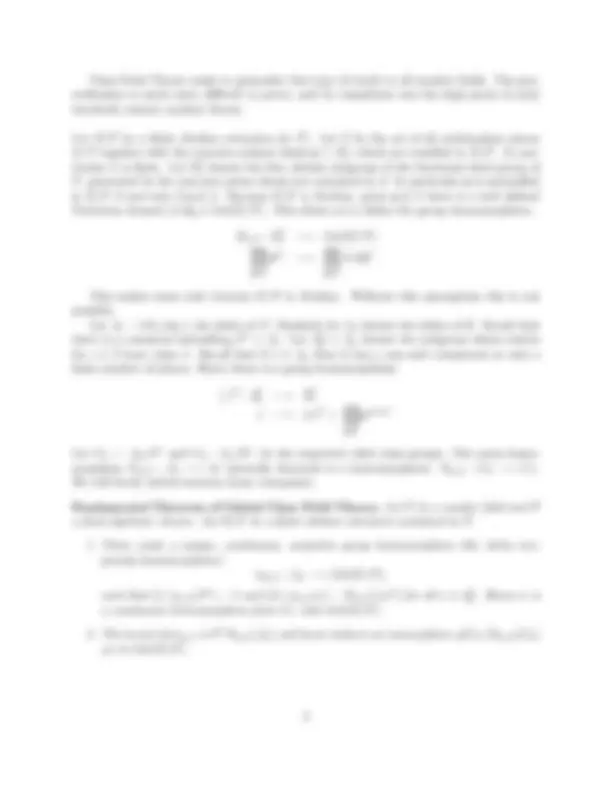
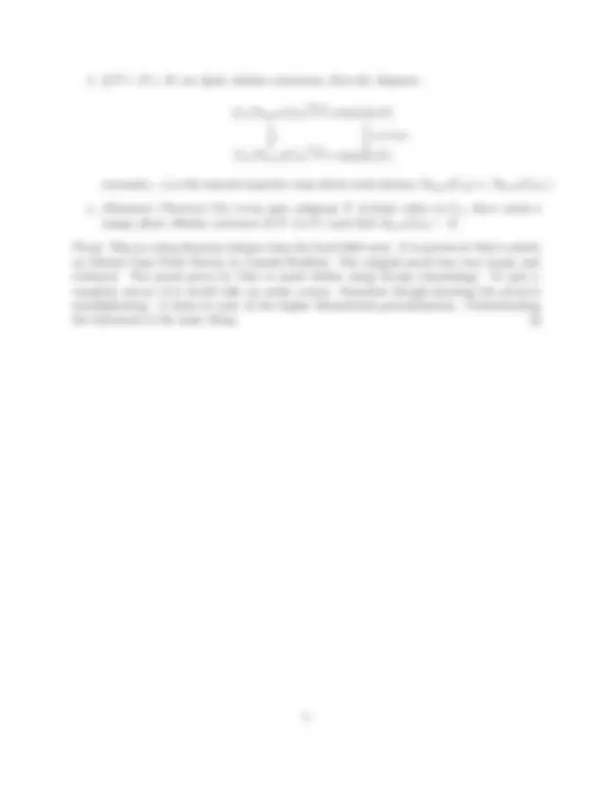
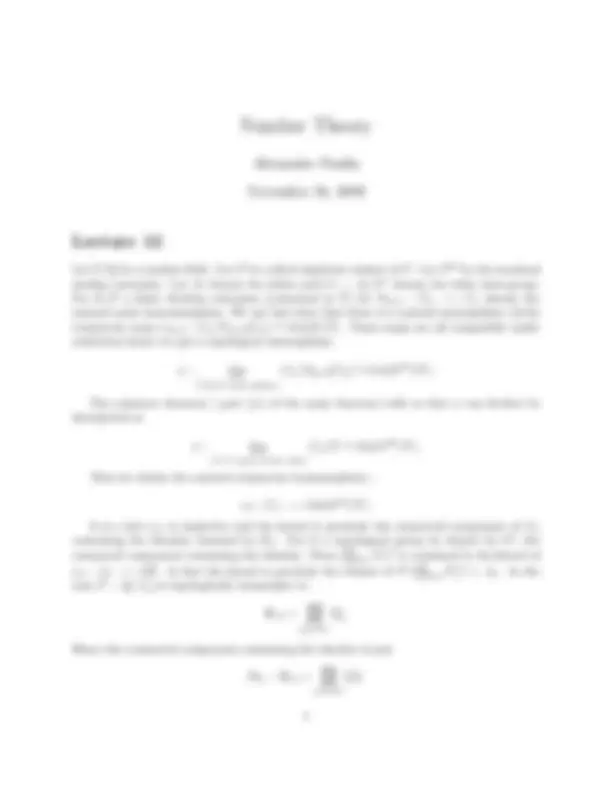
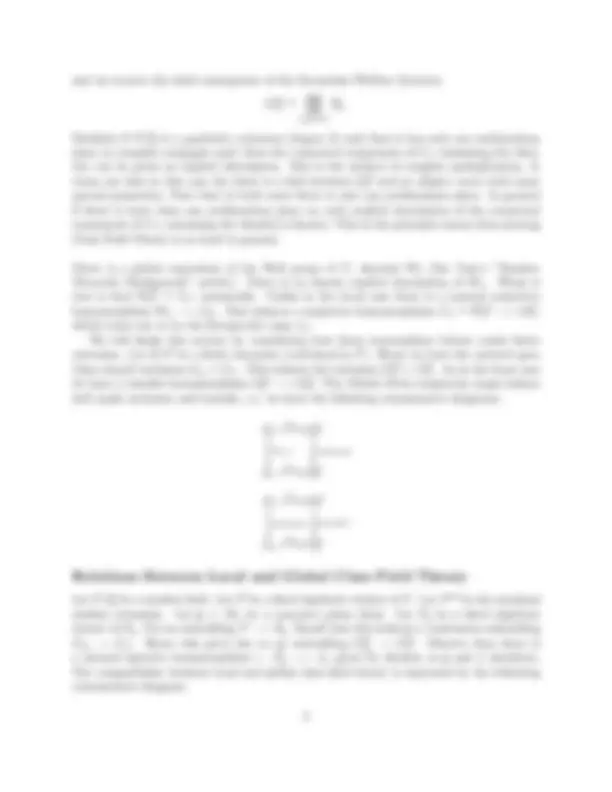

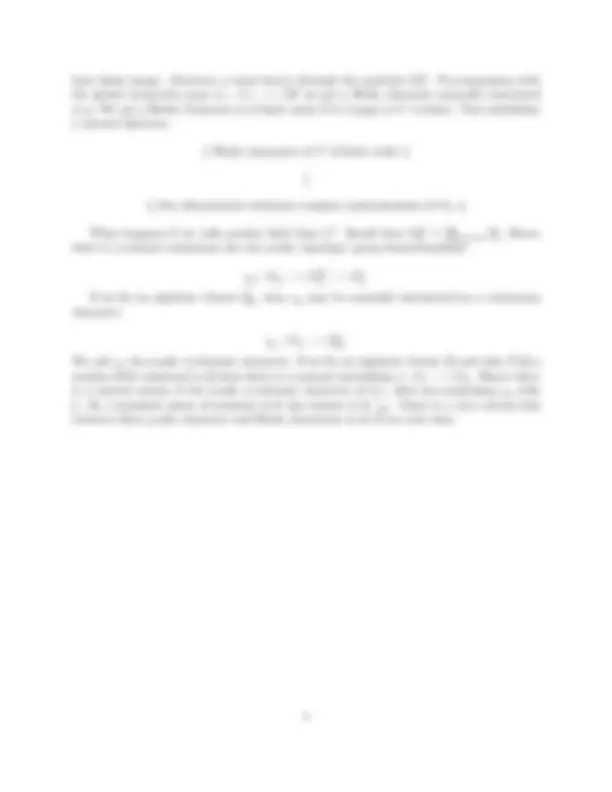
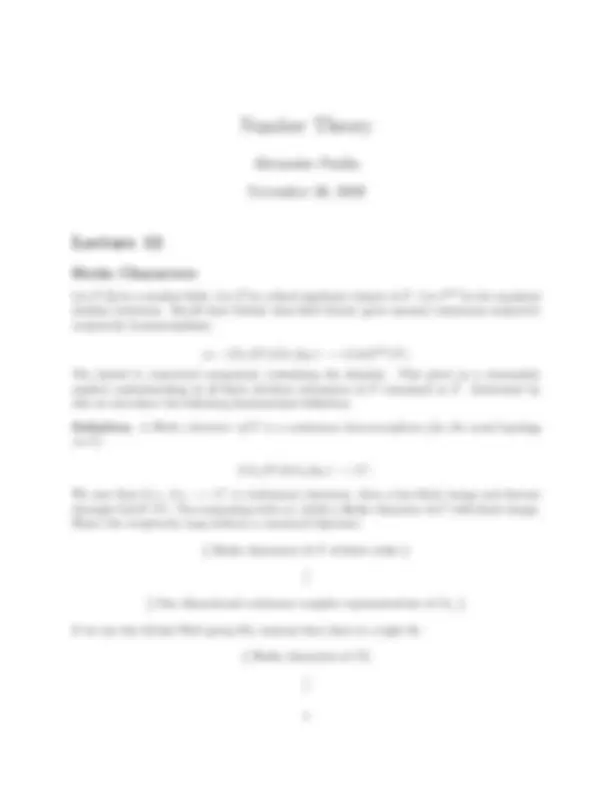
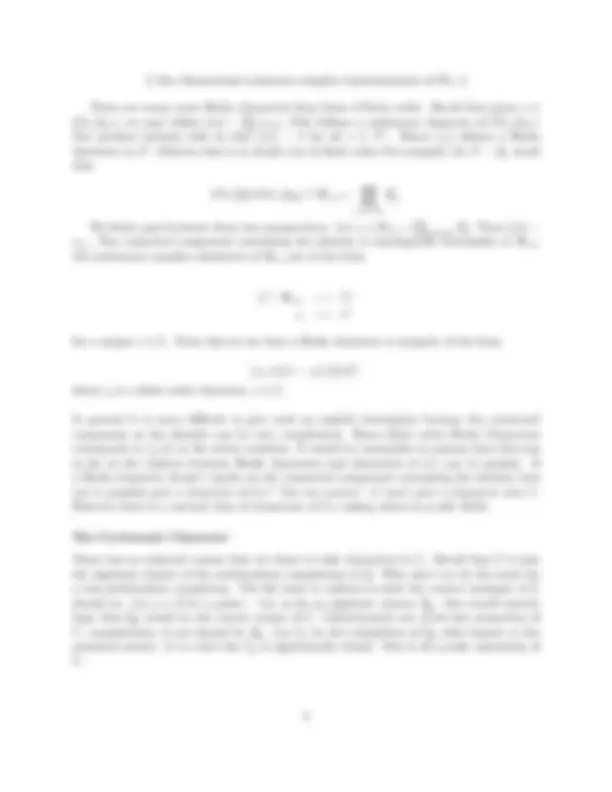
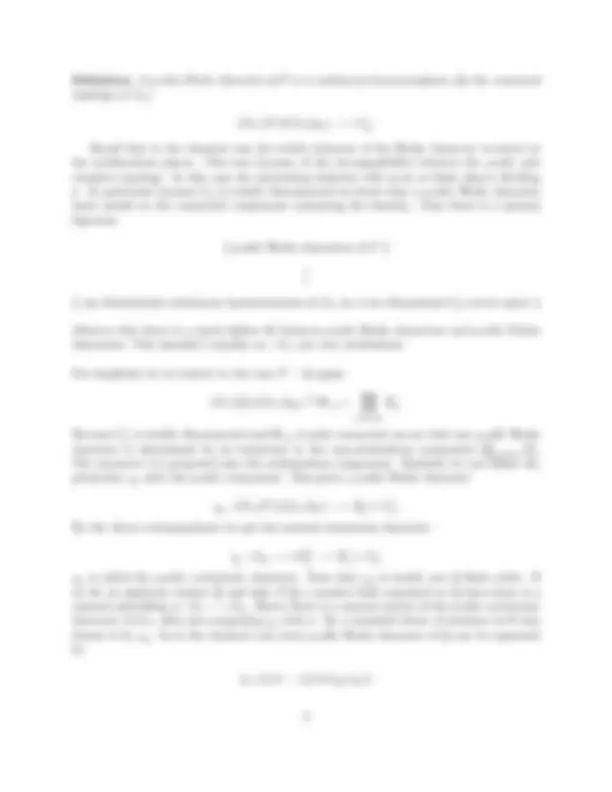
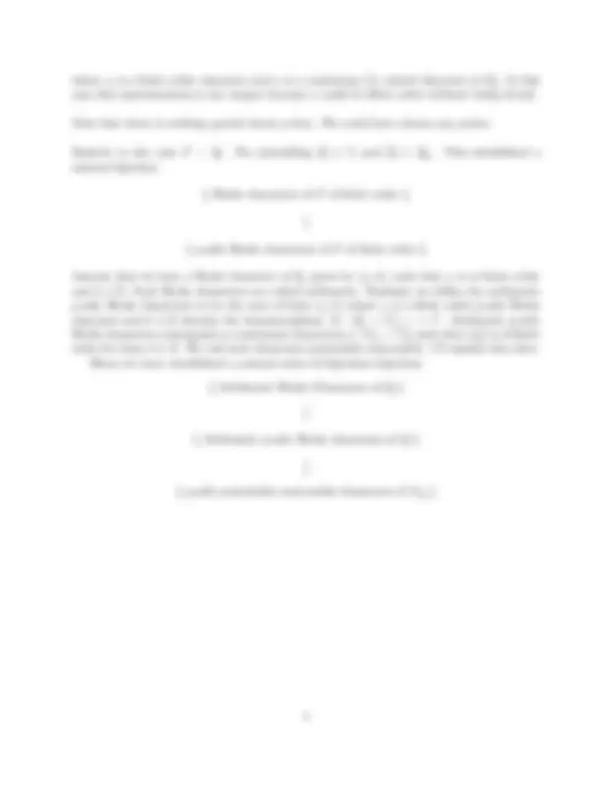
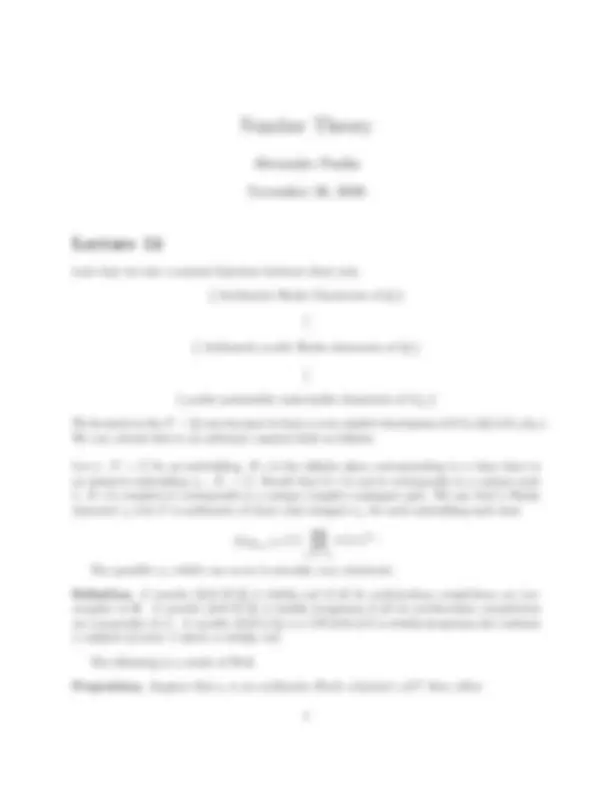
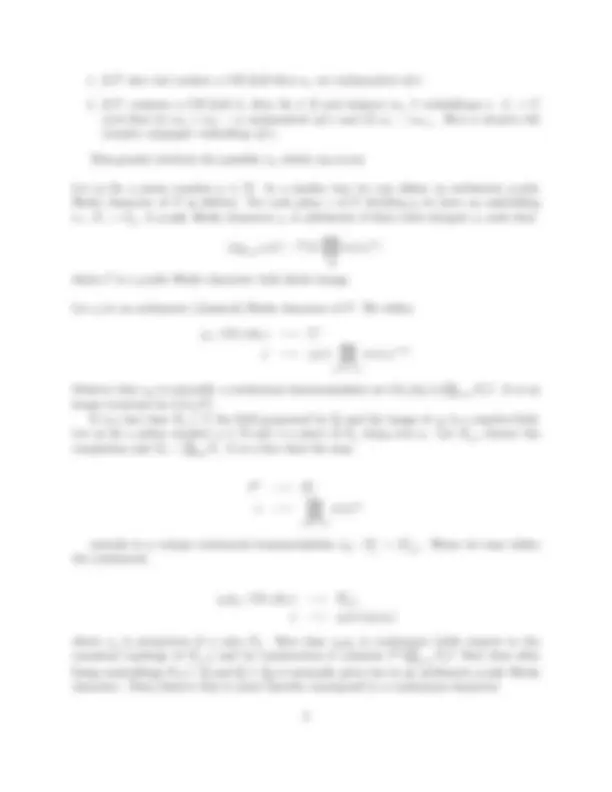
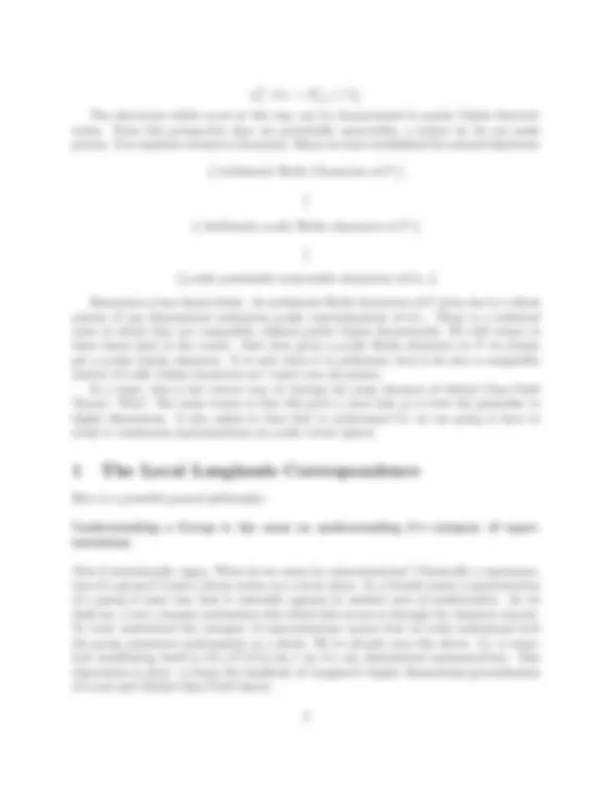
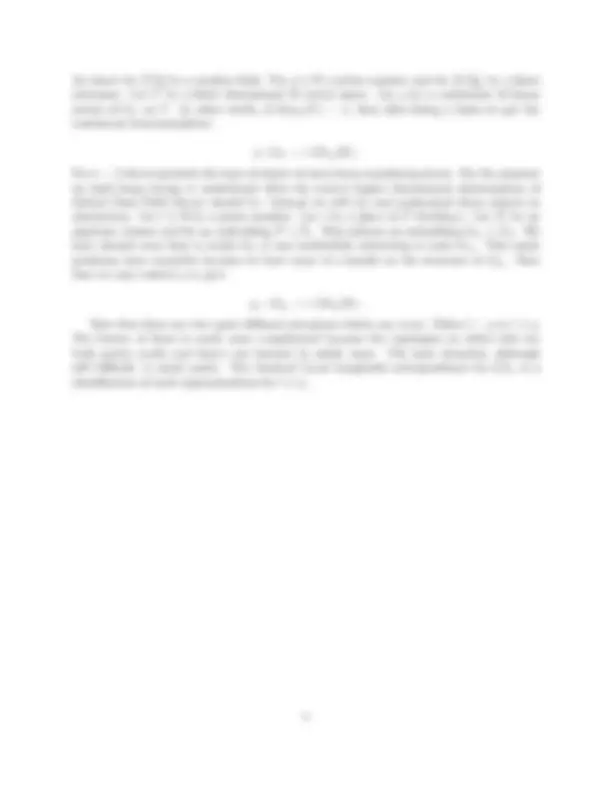
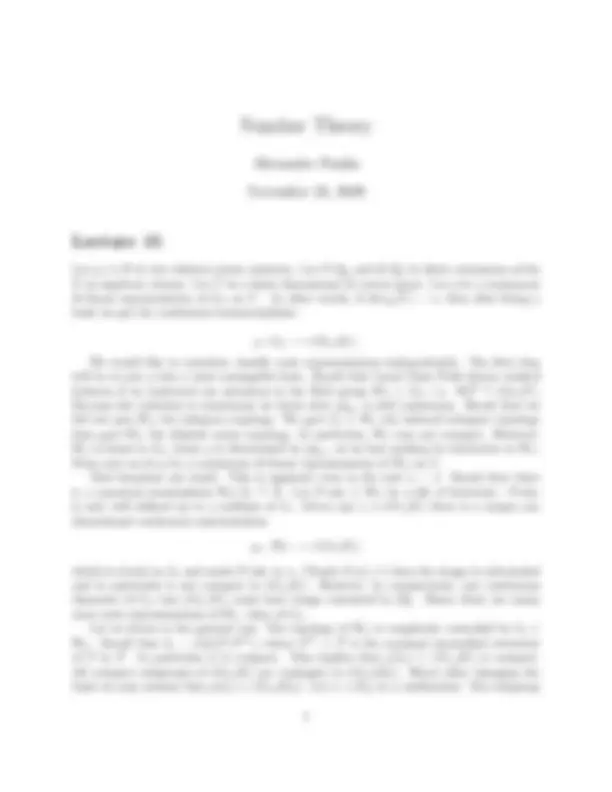
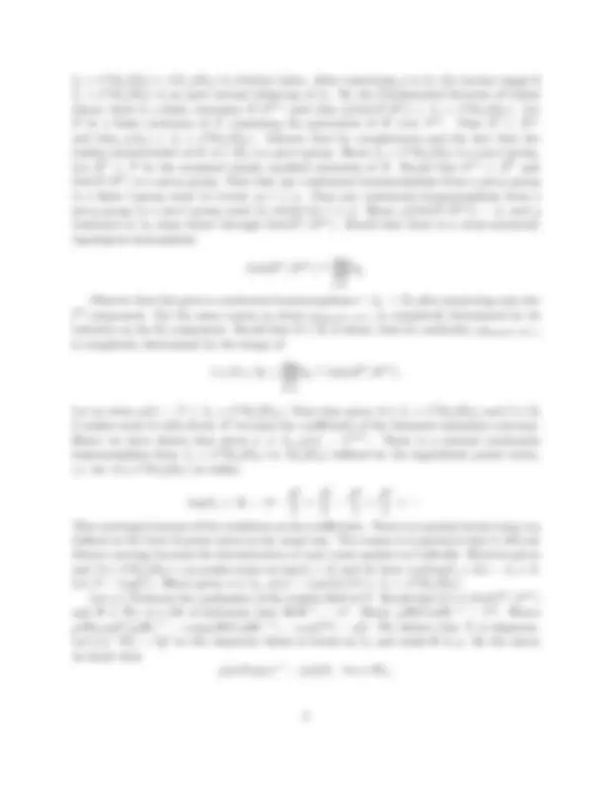
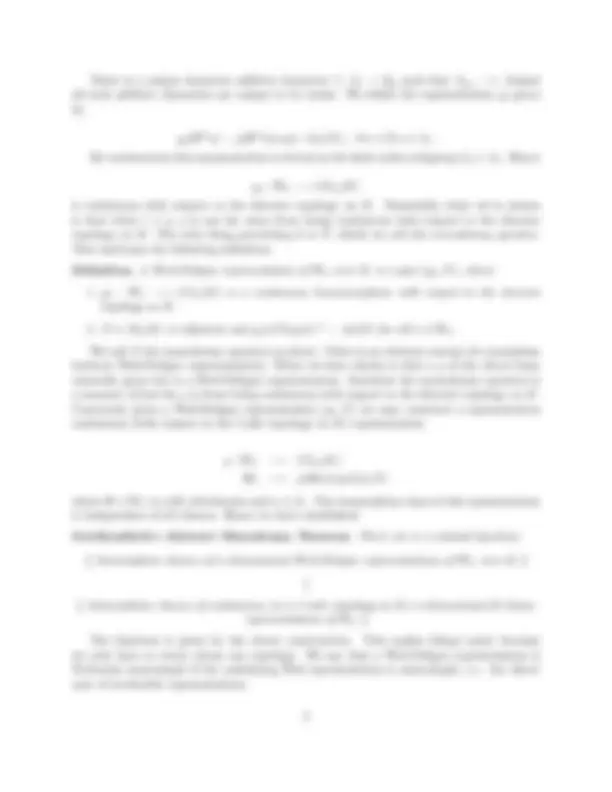
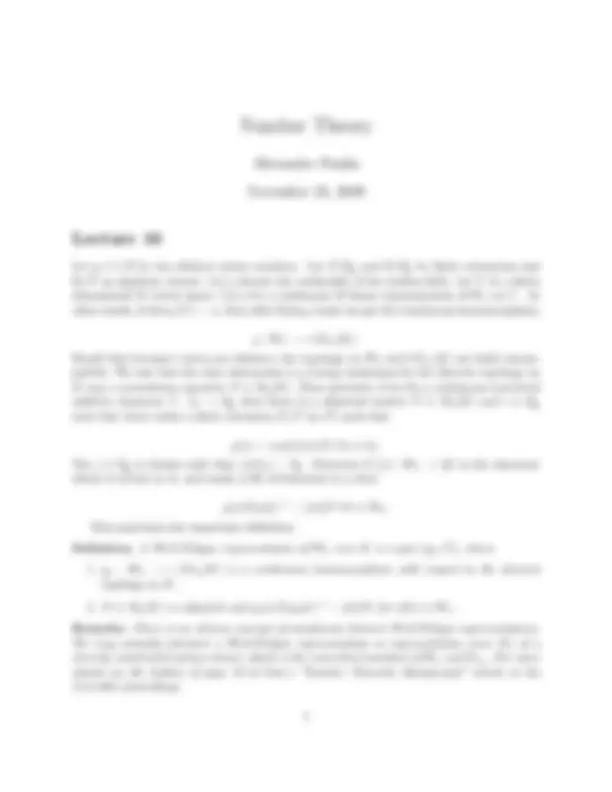
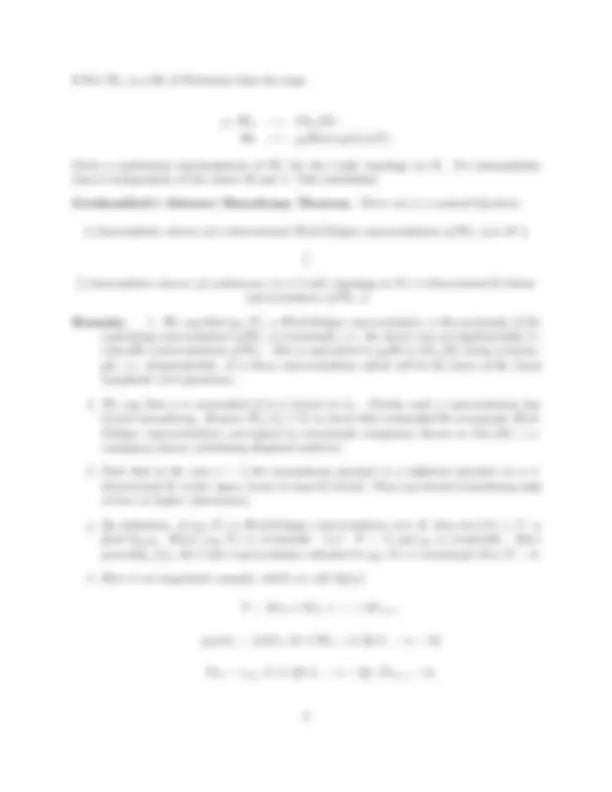
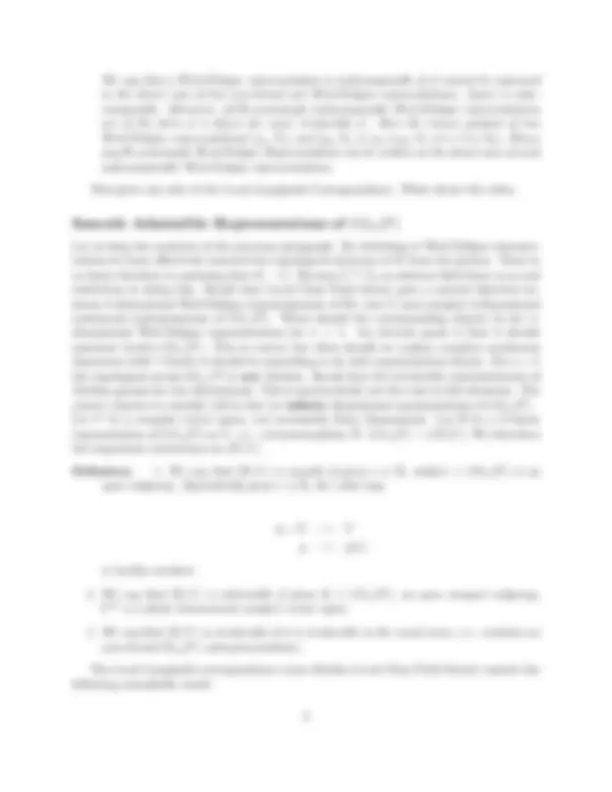
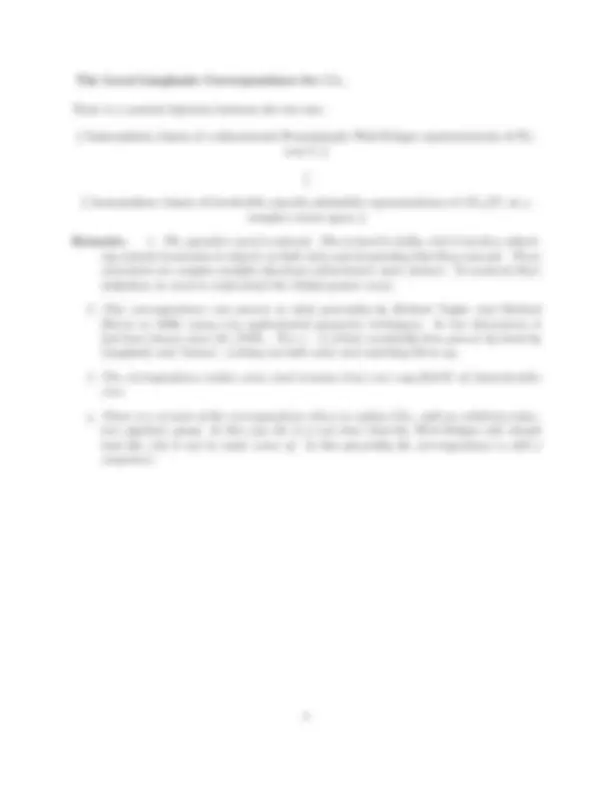
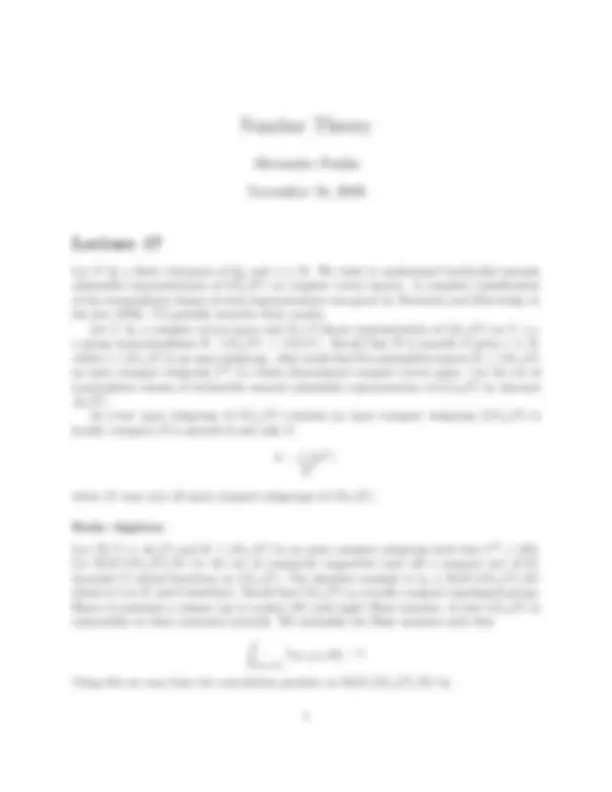
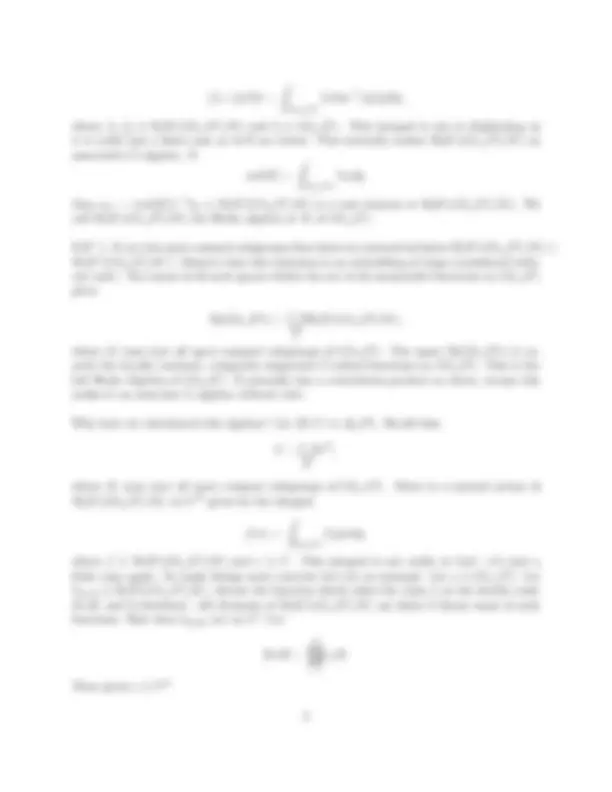
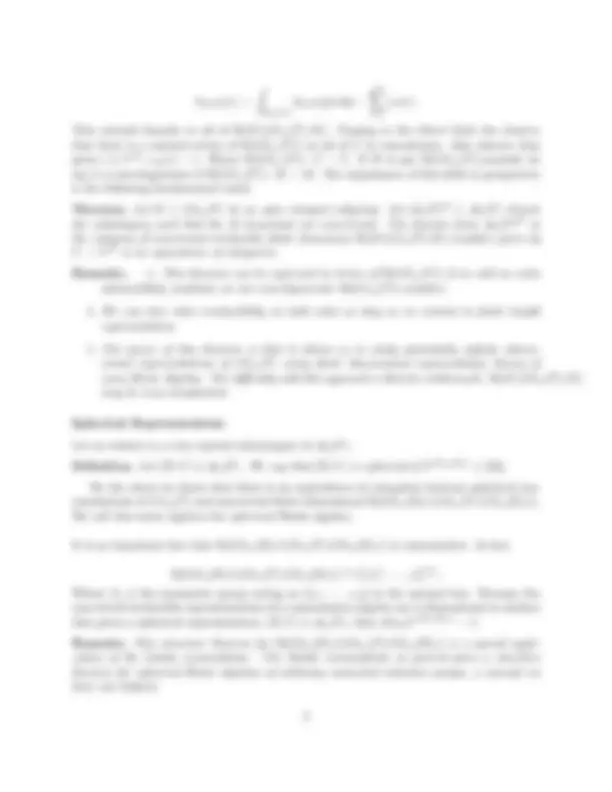
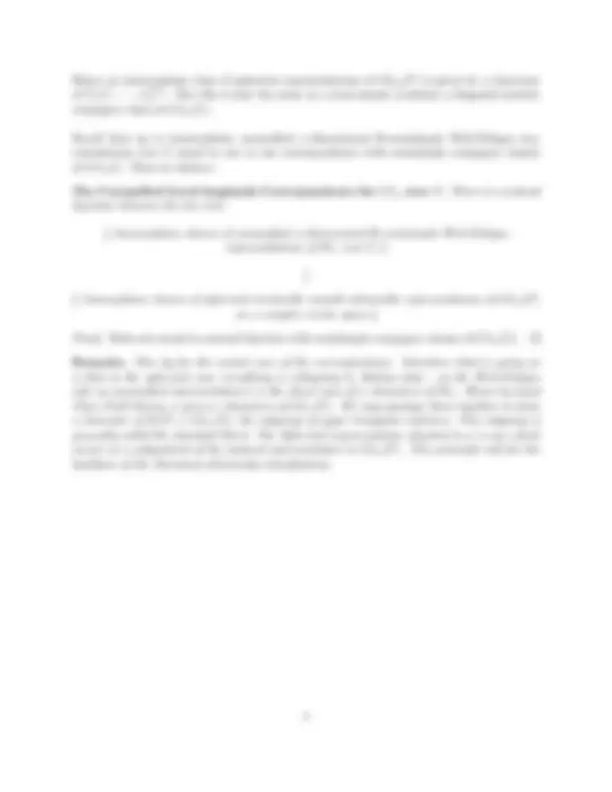
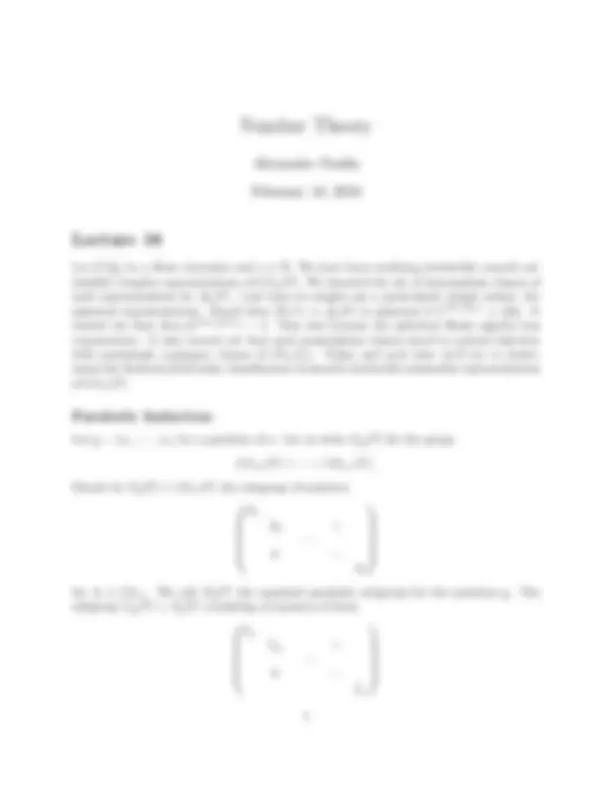
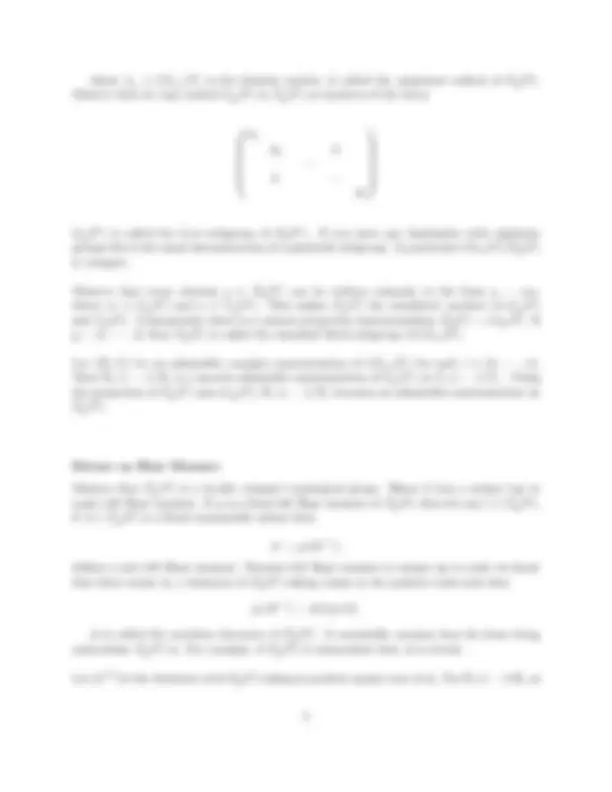
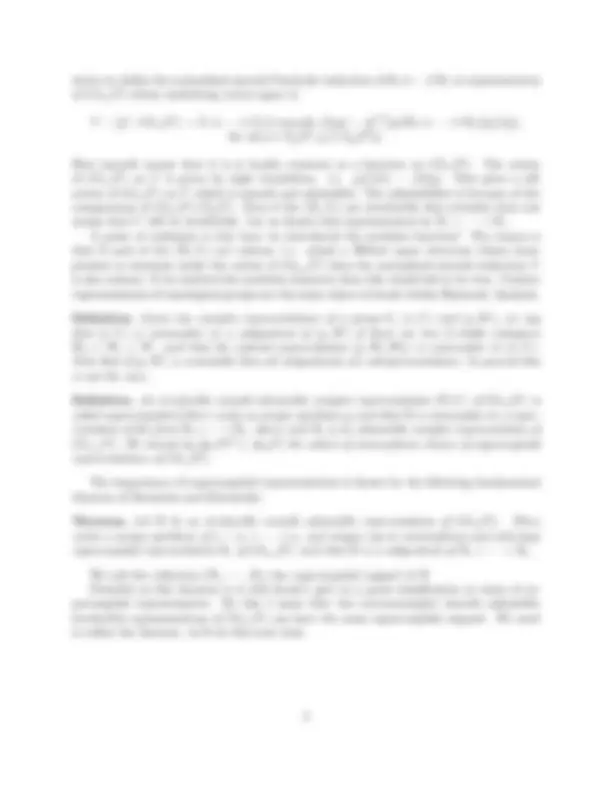
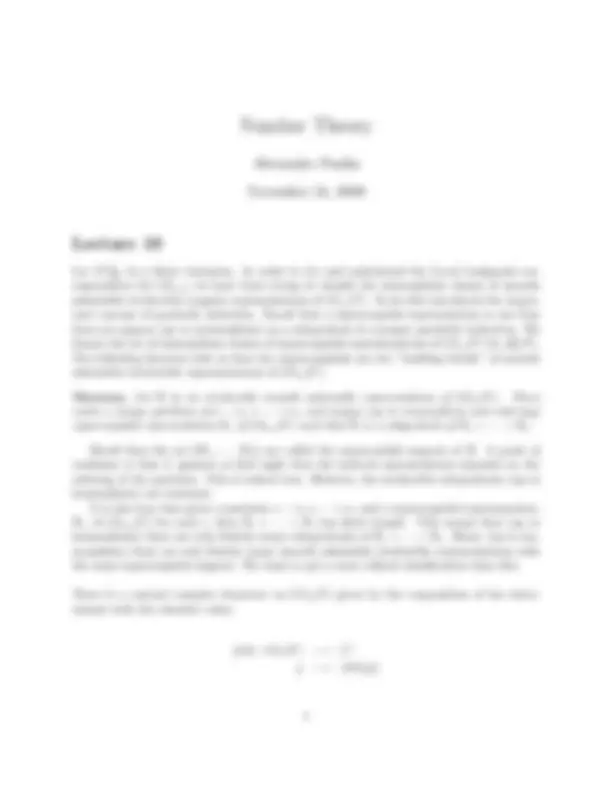
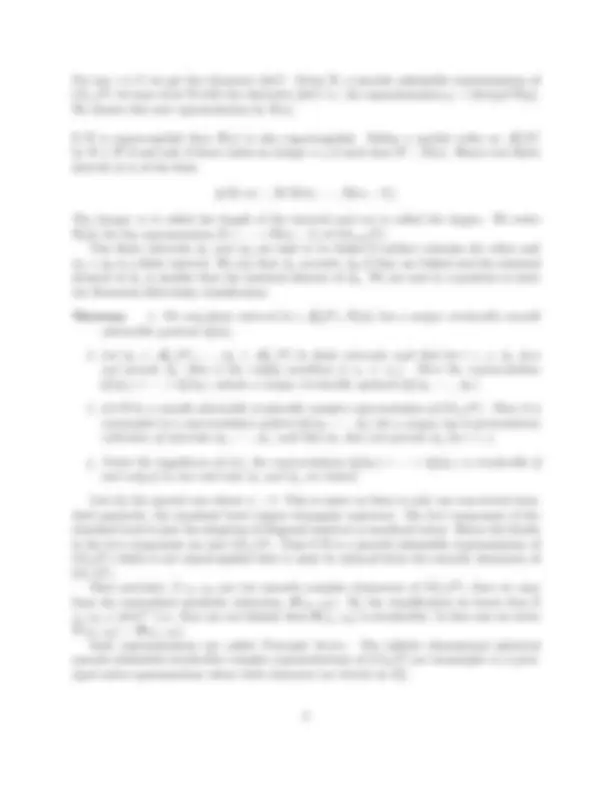
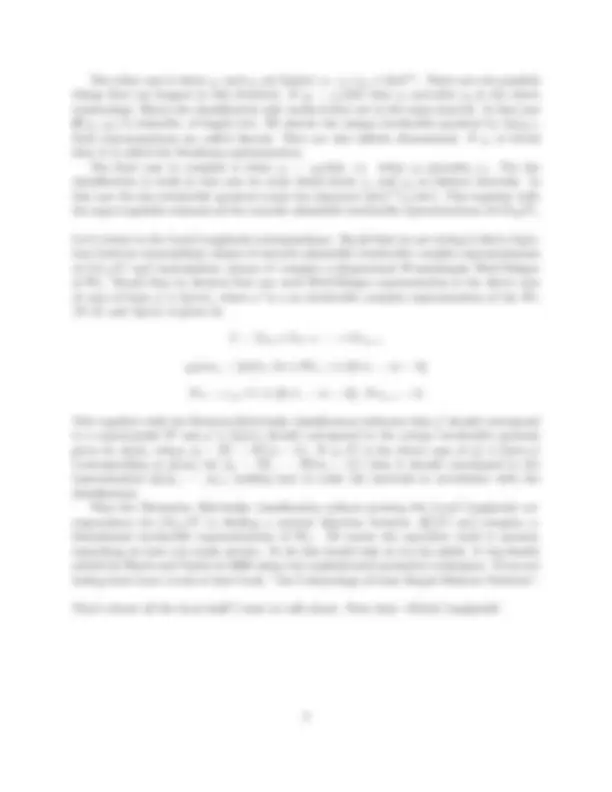
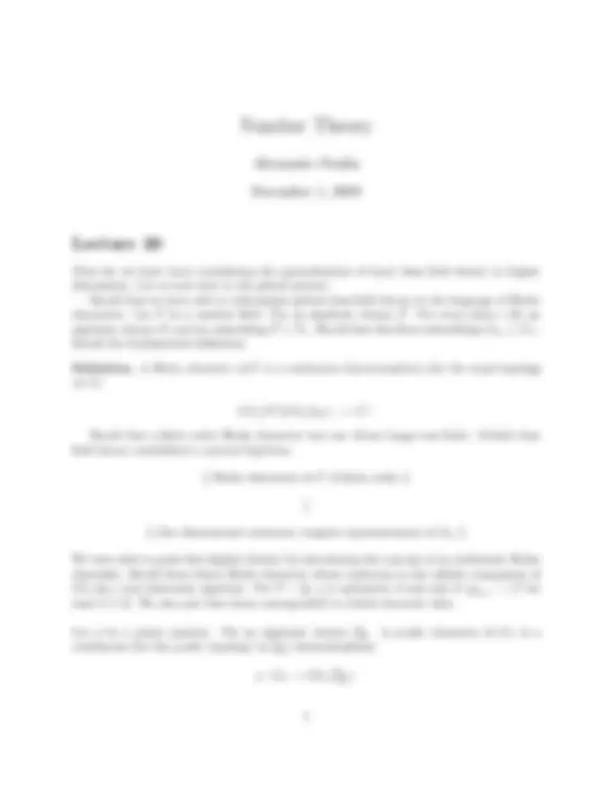
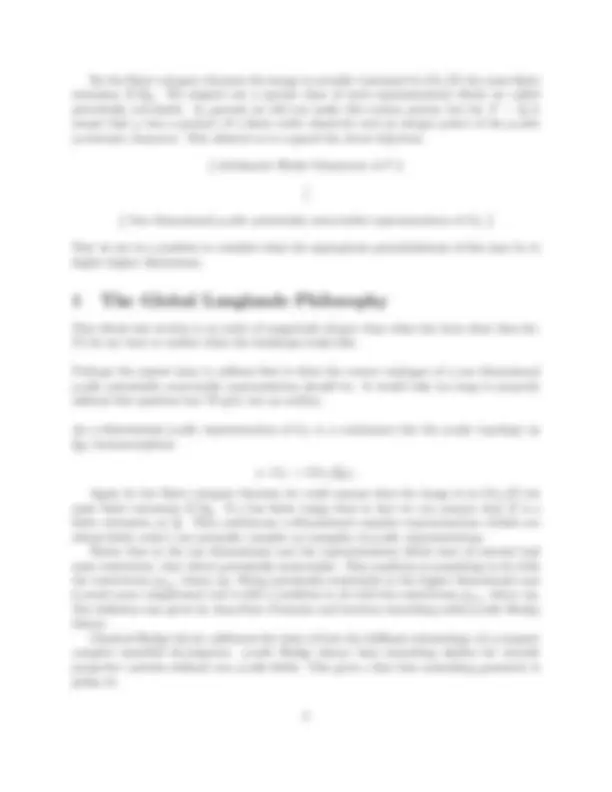
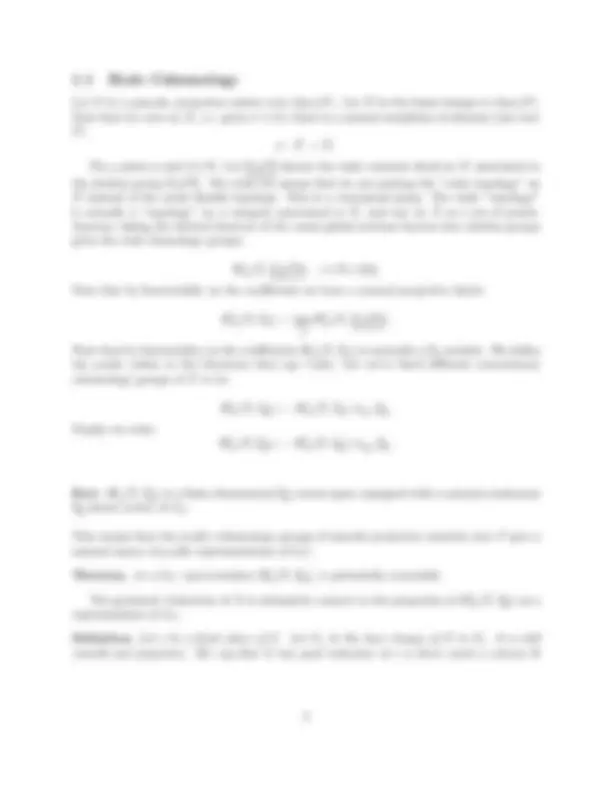
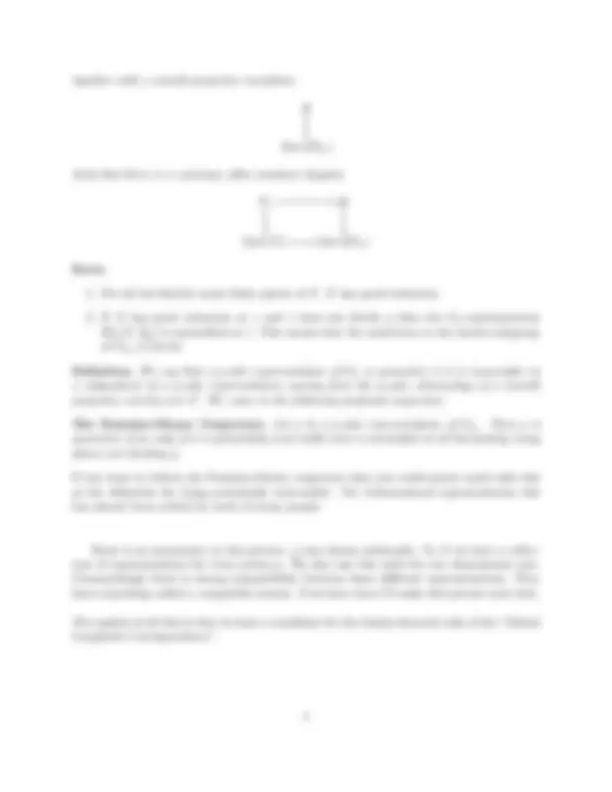
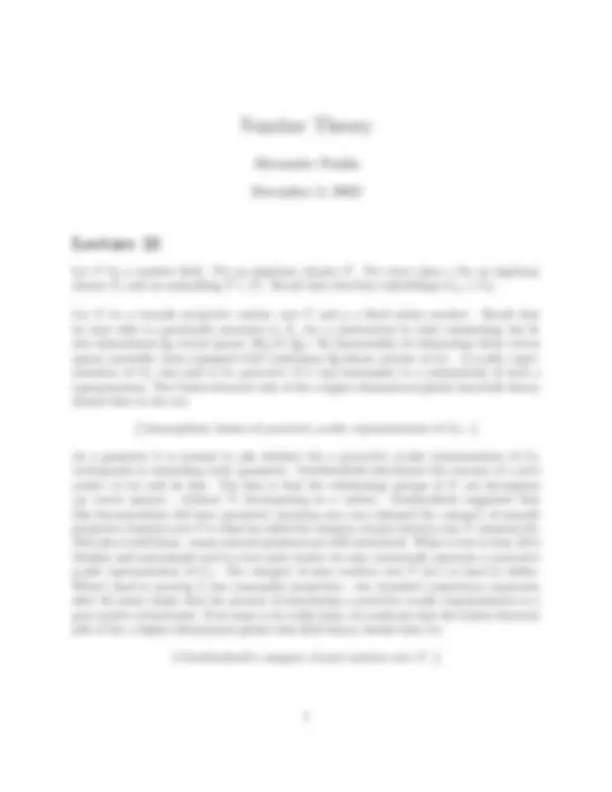
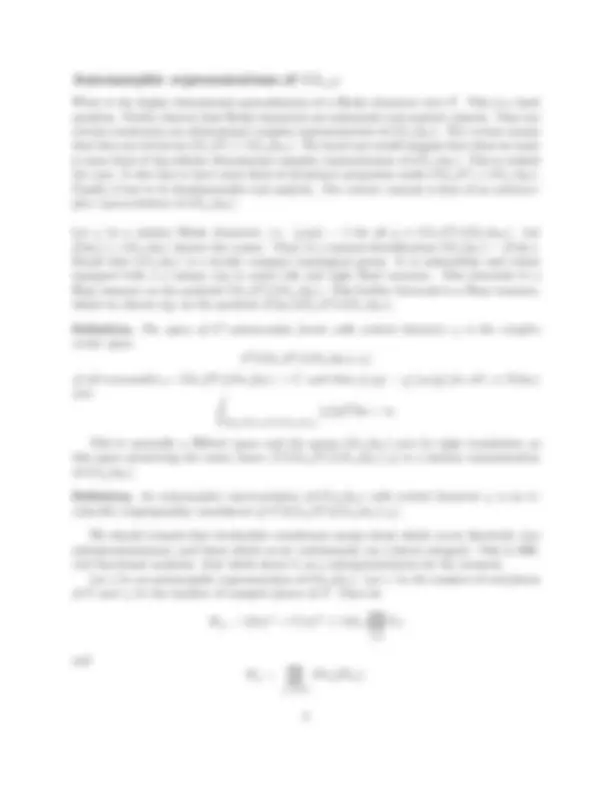
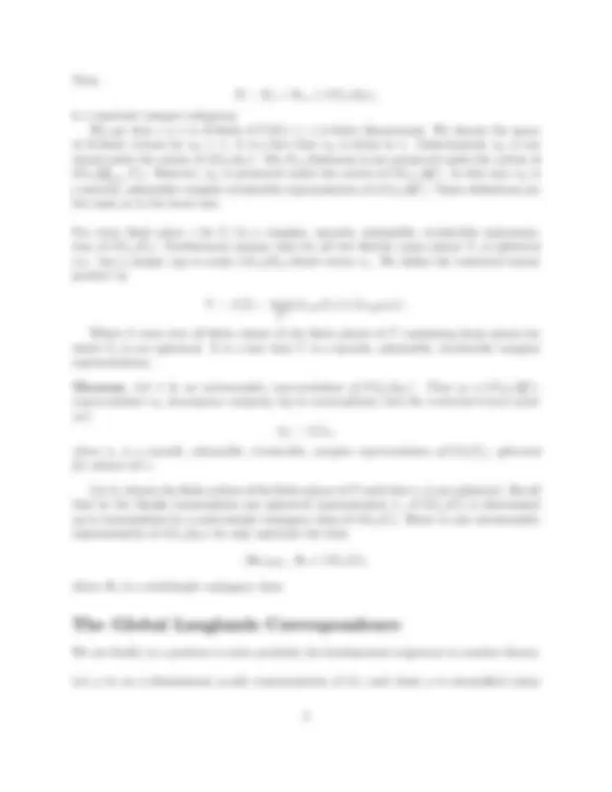
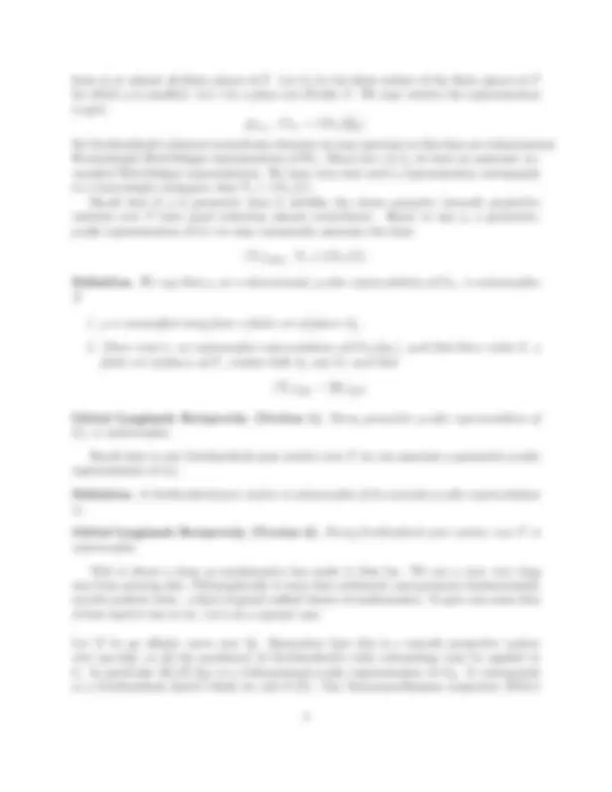



Study with the several resources on Docsity

Earn points by helping other students or get them with a premium plan


Prepare for your exams
Study with the several resources on Docsity

Earn points to download
Earn points by helping other students or get them with a premium plan
Community
Ask the community for help and clear up your study doubts
Discover the best universities in your country according to Docsity users
Free resources
Download our free guides on studying techniques, anxiety management strategies, and thesis advice from Docsity tutors
Number Theory. Lectures by Amaury Thuillier. Notes by Alexis Marchand. ENS de Lyon. S2 2018-2019. M1 course. Contents. 1 Number fields and rings of integers.
Typology: Exercises
1 / 83

This page cannot be seen from the preview
Don't miss anything!












































































Number Theory is one of the oldest and deepest Mathematical disciplines. In the broadest possible sense Number Theory is the study of the arithmetic properties of Z, the integers. Z is the canonical ring. It structure as a group under addition is very simple: it is the infinite cyclic group. The mystery of Z is its structure as a monoid under multiplication and the way these two structure coalesce. As a monoid we can reduce the study of Z to that of understanding prime numbers via the following 2000 year old theorem.
Theorem. Every positive integer can be written as a product of prime numbers. Moreover this product is unique up to ordering.
This is 2000 year old theorem is the Fundamental Theorem of Arithmetic. In modern language this is the statement that Z is a unique factorization domain (UFD). Another deep fact, due to Euclid, is that there are infinitely many primes. As a monoid therefore Z is fairly easy to understand - the free commutative monoid with countably infinitely many generators cross the cyclic group of order 2. The point is that in isolation addition and multiplication are easy, but together when have vast hidden depth. At this point we are faced with two potential avenues of study: analytic versus algebraic. By analytic I questions like trying to understand the distribution of the primes throughout Z. By algebraic I mean understanding the structure of Z as a monoid and as an abelian group and how they interact. We shall be taking the algebraic approach.
Gauss made many fundamental breakthroughs in Number Theory. The one which he is most celebrated for is a well known result called quadratic reciprocity. He himself described it as a golden theorem. I think he proved it when he was 18.
Theorem. Let p and q be distinct odd primes. The congruence equations
x 2 ≡ p (mod q) x 2 ≡ q (mod p)
are either both soluble or insoluble except when both p and q are congruent to 3 modulo 4. In this case exactly one is soluble.
This theorem looks innocuous, but it is profound. Observe that under multiplication p and q are completely unrelated. What quadratic reciprocity is saying is that if we throw addition into the mix then they are. Addition and multiplication are interacting in a highly non-trivial way. Another way of viewing quadratic reciprocity is as some independent way of telling whether the congruence x 2 ≡ p (mod q) is soluble. This holds the key to how this result fits into a broader conceptual framework.
Let f (x) be a monic polynomial of degree n with integer coefficients. A very natural question to ask (the Greeks did it) is how to determine the zeros of f (x) in Q¯ ⊂ C. Up to f (x) of degree 4 this isn’t so hard: they are soluble by radicals. For degree 2 we have the quadratic equation. Beyond that things get harder. Galois was the first to truly understand why. Let E/Q be the minimal subfield of Q¯ containing all the zeros of f (x). This is called the splitting field of f (x) and is formed by adjoining its zeros to Q. E/Q is a finite exten- sion. In fact it is Galois. Any finite field extension is called a number field. Understanding such field extensions is the same as understanding the zeros of f (x), so we’ve translated the problem into more familiar language. So what we’re really interested in is finite field extensions of the rationals. Incidentally all Galois finite field extension of Q arise in this way.
Don’t worry if you don’t know what all these words mean. I what to give you an overview. I’ll introduce them properly later.
Let Gal(E/Q) := field automorphisms of E fixing Q. This group is finite of oder equal to the dimension of E over Q. The Fundamental Theorem of Algebra tells us that E is formed by adjoing the n (possibly repeated) roots of f (x) to Q. Fix an ordering on these roots. Because any element of σ ∈ Gal(E/Q) fixes Q we know that it must permute the roots. Hence we get an injective homomorphism Gal(E/Q) → S (^) n. Observe that there is no canonical way of doing this so we only obtain a conjuagacy class of subgroups of S (^) n. Let p be a prime. We may reduce f (x) mod p to give a polynomial with coefficients in F (^) p. Factor this into it’s irreducible in F (^) p [x] and let n 1 , ..n (^) r be their degrees. Note that n 1 + .. + n (^) r = n. These numbers naturally give a conjugacy class in S (^) n , given by permutations with cycle type (n 1 , ...n (^) r ). The intersection this conjugacy class with any of the images of Gal(E/Q) in S (^) n may give more than one conjugacy class in Gal(E/Q). However, if p does not divide the discriminant of f (x) then this conjugacy class is well defined. Hence for all but finitely many primes p we have a well defined conjugacy class which we denote by f robp ⊂ Gal(E/E), the frobenius at p. It is a fact that all of this only actually depends on E and p, not on
lemma of Dirichlet tells us that we can recover the local L-factors for each p. Also notice that we can detect from L (^) p (ρ, s) whether p is contained in S(E). Hence this meromorphic function knows S(E). We’ve turned a piece of arithmetic into a piece of analysis. Langlands fundamental in- sight was there such a function should be naturally associated to another class of object - an automorphic representation. Automorphic representations are totally analytic. Examples of such things are modular forms. This is amazing. He is essentially saying that they provide the key to truly understanding arithmetic. This is the Langlands Philosophy the guiding force behind a vast swath of modern mathematics. Wile’s proof of Fermat’s Last Theorem involved proving that the L-functions coming from a certain class of Galois representation actually came from modular forms
I wanted to tell you this because the central idea is very elegant and often overlooked in a first course. Clearly there is far too much to cover everything I’ve said here in any depth. What should be clear is that the language of number fields and Galois groups and their representations is fundamental to this whole picture. It is these that we’ll study in the most depth. Hopefully by the end of the course we’ll get to automorphic representations.
Throughout this section all rings will be commutative with unit.
Dedekind Domains
A number field is a finite field extension E/Q. The simplest example is Q. By construction we have the inclusion Z ⊂ Q. Q is the field of fractions of Z. It is elementary to show that Z is a PID, in particular it is Noetherian and all non-zero prime ideals are maximal. This last statement says that it has Krull dimension 1. The Fundamental Theorem of Arithmetic tells us that it is a UFD. A not so obvious property is that Z is integrally closed. This means that if α ∈ Q is a root of a monic polymomial f ∈ Z[X] then α ∈ Z. This is Gauss’ Lemma. The key algebraic properties of Z which we will be interested in are:
Obverse that we’ve left out the fact that Z is a PID. This motivate the following key definition:
Definition. A ring R is a Dedekind domain if it satisfies the above four properties.
Observe that any fields is a Dedekind domain. We want to generalize this to a number field E/Q. First let me remind you about the concept of integral dependence and closure.
Let R be an integral domain (not necessarily Dedekind), K its field of fractions. Let L/K be a finite field extension.
Hence we have seen that in general O (^) E is not a PID or even a UFD. In fact it is true that for a Dedekind domain being a PID is equivalent to being a UFD. At this point this would seem like a catastrophe - how are we going to come up with the concept of a prime for an arbitrary number field? Observe though that if R is a PID then there is a natural bijection between prime elements (up to association) and prime ideals: a → (a). Hence in Z we could think about prime numbers as prime ideals. Recall a prime ideal is proper by convention. To recover a good concept of primes in a Dedekind domain we will switch from the concept of a prime elements to a prime ideals.
Fractional Ideals
Let R be an integral domain, K it’s field of fractions. For R-submodules I 1 , I 2 of K we may define the concept of multiplication: I 1 I 2 ⊂ K, generated by products. If I 1 and I 2 are contained in R then they are ideals in the usual sense and this is just multiplication of ideals. In particular, if R is a PID and I 1 = (a) and I 2 = (b), then I 1 I 2 = (ab). We may also define the concept of addition I 1 + I 2 ⊂ K in the obvious way. If I 1 and I 2 are ideals of R then we say that they are coprime if I 1 + I 2 = R. An R-submodule of K is a fractional ideal of R if it is non-zero and there is a non-zero element a ∈ R such that aI ⊂ R. The simplest example is the free Z-module in Q generated by a non-zero fraction a ∈ Q. It is clear that the product of two fractional ideals is again a fractional ideal. The trivial ideal in R is clearly a fractional ideal.
Proposition. Let R a commutative ring, the following are equivalent:
Proof. This is proposition 1 of §2 of the Local Fields chapter of Cassels/Frohlich.
In fact I −^1 = {x ∈ K|xI ⊂ R}. Hence for R a Dedekind domain, under the operation of multiplication, the fractional ideals of R form an abelian group I(R). Observe that if I ∈ I(R) such that I ⊂ R but I %= R then I −^1 is not contained in R.
Fundamental Fact 2:
Theorem. If R is a Dedekind domain then I(R) is free on the non-zero prime ideals of R.
Proof. This is propostion 2 of §2 of the Local Fields Chapter in Cassels/Frohlich.
Hence given I ∈ I(R) , there is a unique decomposition
p
p vp^ (I)^ ,
where the v (^) p(I) ∈ Z are zero for all but fintely many p. Clearly I ⊂ R ⇐⇒ v (^) p(I) ≥ 0 ∀p. Two ideals of R are coprime ⇐⇒ they share no common prime factor.
Observe that there is a natural homomorphism of abelian groups:
K ∗^ −→ I(R) x −→ (x)
Here (x) denotes the free R-submodule of K generated by x. The kernel of this map is R ∗^. The quotient is called the ideal class group of R. We get the exact sequence:
Where we define CL(R) to be the ideal class group of R. It is an astounding fact, due to L. Claborn, that given any abelian group G, there exists a Dedekind domain such that CL(R) ∼= G. It is clear from the definition that CL(R) = 1 ⇐⇒ R is a PID (equivalently a UFD). For number fields we have the following finiteness condition:
Theorem. For E/Q a number field, CL(O (^) E ) is finite.
Proof. This result is due to Dedekind and Kronecker. It’s theorem 50 of The Theory of Algebraic Number Fields by Hilbert. The proof uses Minkowski’s approach to the geometry of numbers.
As we vary across different number fields the behaviour of these groups is very mysterious. We write h(E) := |CL(O (^) E )|, for the class number of E. Gauss conjectured the following very odd result: the only positive integral values of d such that h(Q(
−d) = 1 are d = 1, 2, 3, 7, 11, 19, 43, 67, 163. This was first proven by a German high school teacher called Kurt Heegner, but no one believe him at first.
It is worth remarking at this point the formal similarity between these ideas and that the Picard group of a smooth projective curve over C. (equivalently a compact Riemann sur- face). In that setting K is replaced by the field of meromorphic functions on your curve and I(R) is the replaced by the divisor group of the curve (the free abelian group on it’s closed points). The reason that these two cases are so similar is that the number fields and transcendence degree one extensions of C share some vary strong algebraic properties. We’ll discuss this further then we start talking about completions of a number field.
So in a Dedekind domain inclusion of ideals is the same as division of ideals. Keeping the above notation, if pO (^) E ⊂ OE is generated by p then pO (^) E ⊂ P and we deduce that P|pO (^) E. In this case we say that P divides p, or that P lies over p.
Proposition. If P ⊂ OE is a prime ideal then is divides one and only one prime p ⊂ OF.
Proof. By the above we know that P divides at least one prime. Assume that P divides the distinct prime ideals p 1 and p 2. Note that because these two primes are distinct they are coprime and hence p 1 + p 2 = O (^) F. Hence they generate the unit ideal in O (^) E. By assumption this implies P|OE , a contadiction as P is a proper ideal.
Let p ⊂ OF be a prime ideal. Let P|pO (^) E. We define the ramification index to be
e(P/p) = v (^) P(pO (^) E ).
Similarly we define the residue class degree to be:
f (P/p) = [F (^) P : F (^) p].
These behave well with respect to towers of extensions, i.e. if K/E/F are number fields and we have a three primes P ∈ OK , P ⊂ OE and p ⊂ OF such that P|PO (^) K and P|pO (^) E , then e(P/p) = e(P/P)e(P/p) and f (P/p) = f (P/P)f (P/p).
We know we may completely factor pO (^) E as follows:
pO (^) E = Pe 11 .....Pe mm ,
for some m ∈ N, where each Pi is a prime ideal of O (^) E and ei = e(Pi /p). For simplicity of notation we write fi = f (Pi /p).
Theorem.
∑m i=1 ei^ fi^ = [E^ :^ F^ ].
Proof. This is proposition 1 of §10 of the Local Fields chapter of Cassels/Frohlich.
Definition. Let p ⊂ OF be a prime ideal.
Galois Extensions
Now assume that E/F is a Galois extension. For a general field extension this means that it is algebraic (automatic in our case because it is finite) and if Aut(E/F ) = field automor- phisms of E fixing F then E Aut(E/F^ )^ = F. In this case we write Gal(E/F ) = Aut(E/F ), the Galois group of E/F. Clearly Gal(E/F ) preserves O (^) E. It is a standard result from basic Galois theory that if E/F is finite then [E : F ] = |Gal(E/F )|.
Let P ⊂ O (^) E be a prime ideal and σ ∈ Gal(E/F ). We denote by σP ⊂ O (^) E the image of P under σ. It is elementary to show that σP is a prime ideal and if p ⊂ OF is a prime ideal such that P|pO (^) E then σP|pO (^) E. It is clear also that e(P/p) = e(σP/p) and f (P/p) = f (σP/p)
Proposition. Let E/F be a Galois extension of number fields. Let p ⊂ OF be a prime ideal. Then Gal(E/F ) acts transitively on the primes dividing p.
Proof. This is proposition 2 of §10 of the Local Fields chapter of Cassels/Frohlich.
Corollary. Let E/F be a Galois extension of number fields. Let p ⊂ OF be a prime ideal. If P ⊂ O (^) E is a prime ideal dividing pO (^) E then it’s ramification index and residue class degree only depend on p.
Ramification, Traces and Norms
Let E/F be a finite extension of number fields. Given x ∈ E there is a natural F -linear maps of vector spaces:
φx : E −→ E y −→ xy
Thinking about this as a map of finite dimensional F -vector spaces we may compute it’s trace and determinant:
Definition. 1. We define the Trace map of E/F by:
T r (^) E/F : E −→ F x −→ trace(φx )
N (^) E/F : E −→ F x −→ det(φx )
It is easy to show that T r (^) E/F (O (^) E ) ⊂ OF and N (^) E/F (O (^) E ) ⊂ OF
Proposition. η is surjective.
Proof. This is proposition 14 of §5 of Chapter 1 of Algebraic Number Theory by Serge Lang.
Let E/F be a Galois extension of number fields, with Galois group Gal(E/F ). Let p ⊂ OF be a non-zero prime ideal. We have the non-zero prime factorisation (in O (^) E )
pO (^) E = Pe 1 ....Pem ,
where e = e(p), the ramification index. All the exponents are equal because the extension is Galois. Recall that for almost all such p, e(p) = 1. Similary the residue class degrees of each Pi over p are all equal and we denote their common value by f (p). We know from lecture 3 that |Gal(E/F )| = [E : F ] = m × e(p) × f (p).
Let P = Pi for some i ∈ { 1 , ...., m}. Recall that decomposition group at P is
G(P) := {σ ∈ Gal(E/F )|σP = P}.
The action Gal(E/F ) on the primes dividing p is transitive. Thinking about Gal(E/F ) as a finite group acting on the set of m primes dividing p, we see by the orbit-stabiliser theorem that |G(P)| = e(p) × f (p).
We also observed that there was naturally a homomorphism
η : G(P) −→ Gal(F (^) P/F (^) p),
which was in fact surjective.
Definition. The kernel of η, denoted T (P), is the inertia subgroup of Gal(E/F ) at P.
Proposition. |T (P)| = e(p).
Proof. We know that |Gal(F (^) P/F (^) p)| = [F (^) P : F (^) p] = f (p). Because η is surjective and |G(P)| = e(p) × f (p) we deduce from the 1st isomorphism theorem that |T (P)| = e(p).
Hence for almost all non-zero primes p ⊂ OF (i.e. those not dividing D(E/F )) we know that G(P) ∼= Gal(F (^) P/F (^) p) for every non-zero prime P ⊂ OE dividing p.
Let us now restrict to the case where E, F and K are number fields. Furthermore let us assume that E/F and K/F are both Galois. It is not hard to show that EK/F is a Galois extension and there is a natural injective homorphism:
φ : Gal(EK/F ) −→ Gal(E/F ) × Gal(K/F ) σ −→ (res (^) E (σ), res (^) K (σ))
In general φ is not an isomorphism, except in the case when E ∩ K = F. If P ⊂ OEK is a non-zero rime ideal lying over P ⊂ OK and P ⊂ OE then it is true that:
φ((EK/F, P)) = ((E/F, P), (K/F, P)).
In this sense the Frobenius element respects composition of fields.
Let σ ∈ Gal(E/F ). Then G(σP) = σG(P)σ −^1. Consequently (E/F, σP) = σ(E/F, P)σ −^1. Hence, in general there is no canonical way of associating a Frobenius element to a non-zero prime ideal p ⊂ OF. Instead we have:
Definition. Let p ⊂ OF be a non-zero prime ideal and P ⊂ OE a non-zero prime ideal lying over p. We define the Frobenius class at p to be the conjugacy class
F rob (^) p := {σ(E/F, P)σ −^1 |σ ∈ Gal(E/F )} ⊂ Gal(E/F )}.
Because Gal(E/F ) acts transitively on the primes lying over p and the previous comment this is well defined. Observe that F rob (^) p = { 1 } ⇐⇒ p splits completely in E. We say that E/F is Abelian if Gal(E/F ) is an Abelian group. This is a very restrictive property. Global Class Field Theory gives a way of classifying such extensions. It crucially relies on the fact that in this case F rob (^) p is a well defined element of Gal(E/F ). We will return to this once we have introduced the important concept of a local field.
Tchebotarev Density Theorem. Let E/F be Galois extension of number fields. Let C ⊂ Gal(E/F ) be a conjugacy class. Then the primes p ⊂ OF such that F rob (^) p = C have density |C|/|Gal(E/F )| in the set of all non-zero prime ideals. In particular there are infinitely many such primes.
Remarks. 1. By density we mean density in the sense of Dirichlet, i.e. If F = Q then the density of S, a subset of the primes numbers equals the limit as n tends to ∞ of
(Number of elements of S less than n) / (Number of primes less than n).
Theorem. Let E/F and K/F be two Galois extensions of number fields (thought of as both lying in a fixed algebraic closure F¯ ). Let Spl(E/F ) and Spl(K/F ) denote the subset of non-zero prime ideals in O (^) F which split completely in E and K respectively. Then
E ⊂ K ⇐⇒ Spl(K/F ) ⊂ Spl(E/F ).
Proof. If E ⊂ K we know by the multiplicative behavior of ramification index and residue class degree in towers of extensions that Spl(K/F ) ⊂ Spl(E/F ). Let us assume that Spl(K/F ) ⊂ Spl(E/F ). Let p ⊂ OF be a non-zero prime ideal. Observe that because Frobenius respects composition of fields
p splits completely in EK ⇐⇒ p splits completely in both E and K.
Hence in general we have Spl(EK/F ) = Spl(E/F ) ∩ Spl(K/F ). We deduce that
Spl(K/F ) ⊂ Spl(E/F ) ⇒ Spl(EK/F ) = Spl(K/F ).
By the Tchebotarev density theorem we deduce that [EK : F ] = [K : F ] ⇒ E ⊂ K.
Hence number fields which are Galois over Q are determined (up to isomorphism) by the primes in Z which split completely. Let me give you another powerful consequence of the density theorem.
Crash Course on Cyclotomic Fields
Let n ∈ N. Fix ζn ∈ C, a primitive nth root of unity. We denote by Q(ζn ), the splitting field of f (x) = x n^ − 1. Q(ζn )/Q is finite and Galois. If σ ∈ Gal(Q(ζn )/Q) then σ(ζn ) is again a primitive nth root of unity. This establishes an isomorphism
χ : Gal(Q(ζn )/Q) −→ (Z/nZ)∗^ ,
where σ(ζn ) = ζ χ n (σ). Hence Q(ζn )/Q is an Abelian extension. It can be shown that a prime p ∈ Z ramifies in Q(ζn ) if and only if p|n. Note that because Z is a PID we can freely switch between the concept of an ideal and a positive integer. Hence given p ∈ Z coprime to n we get a canonical element F rob (^) p ∈ Gal(Q(ζn )/Q).
Proposition. F rob (^) p (ζn ) = ζ (^) np
Proof. This is the proposition in §3.4 of Tate’s article on Global Class Field Theory in Cassels/Frohlich.
Dirichlet’s Theorem on Arithmetic Progressions. Let a ⊂ Z be coprime to n. Then the arithmetic progression S = {a + kn|k ∈ N} contains infinitely many primes.
Proof. Because a is coprime to n is defines a unique element of (Z/nZ)∗^ , which we denote by [a]. By the Tchebotarev density theorem the know that there exist infinitely many primes p ∈ Z such that χ(F rob (^) p ) = [a]. But by the previous proposition we know that this occurs precisely when a and p are congruent modulo n. Hence there are infinitely many such primes.
The Tchebotarev density theorem is a vast generalization of this result.
Because a P ID is always integrally closed we deduce that R is a DVR ⇐⇒ R is a Dedekind domain with exactly on non-zero prime ideal. Being a Dedekind domain is preserved under localisation at a prime ideal. Hence If R is a Dedekind domain, and p ⊂ R is a non-zero prime ideal then R (^) p is a DVR. Conversely, a Noetherian domain R which is not field is Dedekind ⇐⇒ for every non-zero maximal ideal p ⊂ R, R (^) p is a DVR. All of these results are very standard and can be found in An Introduction to Commutative Algebra by Atiyah and Macdonald.
Definition. Let F be a field. An absolute value on F is a function |.| : F −→ R (^) + such that:
These conditions force | 1 |^2 = | 1 |, so | 1 | = 1. Similarly | − 1 | = 1 Hence | 1 /x| = 1/|x| and | − x| = |x| for all x ∈ F ∗^. The canonical example of a field with an absolute value is any subfield of C together with the usual absolute value. If (F, |.|) is a field with an absolute value then we may canonically define a metric on F : for x, y ∈ F d(x, y) := |x − y|. We may define the trivial absolute value on a field by |x| = 1 ∀x ∈ F ∗^. In general we will be interested in non-trivial absolute values. The resulting topology on F makes it a topological field.
Let (F, v) be a Field together with a discrete valuation. Fix c ∈ (0, 1). We may define the absolute value |.|v,c on F by
|.|v,c : F −→ R (^) + x −→ c v(x)
Strictly speaking this function is not defined at zero so we set | 0 |v,c = 0.
Theorem. Let |.| and |.|′^ be two absolute values on a field F. Then they induce the same topology on F ⇐⇒ there exists e > 0 such that |.|′^ = |.|e^.
Proof. This is the second lemma of §4 of the Global Fields Chapter of Cassels/Frohlich.
We call two such absolute values equivalent. We deduce from this result that if (F, v) is a field with discrete valuation then the topology defined above by the absolute value is independent of the choice of c.
Definition. Let (F, |.|) be field together with an absolute value. We say that |.| is non- archimedean if the ultrametric triangle inequality holds:
∀x, y ∈ F |x + y| ≤ max{|x|, |y|}.
If this does not hold we say that |.| is archimedean.
This is a very strong condition. For example, it forces |k| ≤ 1 for all k ∈ Z. Any absolute value coming from a discrete valuation is non-archimedean. If |.| is a non-archimedean absolute value on F then all equivalent absolute values are non-archimedean.
Theorem. Any field F with an archimedean absolute value is isomorphic to a subfield of C, the absolute value being equivalent to the one induced by the absolute value on C.
Proof. See pages 45 and 67 of The Theory of Algebraic Numbers by E. Artin.
So fields with archimedean absolute values are familiar objects. Let us now focus on the non-archimedean case. Let (F, |.|) be a field together with a non-archimedean absolute value. Let a ∈ F and r ∈ R r > 0. The closed ball of radius r around a defined to be
B¯r (a) := {x ∈ F ||x − a| ≤ r}.
Let b ∈ B¯r (a). Consider the open ball of radius r/2 around b,
Br/ 2 (b) := {x ∈ F ||x − b| < r/ 2 }.
Observe that if c ∈ Br/ 2 (a) then
|c − a| = |(c − b) + (b − a)| ≤ max{|c − b|, |b − a|} ≤ r.
Hence Br/ 2 (b) ⊂ B¯r (a). We deduce that B¯r (a) is in fact open! A similar argument shows that all triangles in F are isosceles!
Definition. A topological space is totally disconnected if the only non-empty connected sub- sets are one point sets.
Theorem. Let (F, |.|) be a field with a non-archimedean absolute value. Then F is totally disconnected under the induced topology.
Proof. Let X ⊂ F be a connected subset having two distinct points x 0 , x 1 ∈ X. Choose r > 0 such that r < |x 0 − x 1 |. We have a disjoint union
X = (X ∩ {|x − x (^) o | ≤ r}) ∩ (X ∩ {|x − x (^) o |r})
By the above we know that each piece is open (the the subset topology) in X. Note that each piece is non-empty as x 0 is in the first and x 1 is in the second. This contradicts the assumption that X is connected.
Hence the topology in the non-archimedean case is wildly different than in the archimedean case. Observe that in the non-archimedean setting R = {x ∈ F ||x| ≤ 1 } is a subring. Similarly M = {x ∈ F ||x| < 1 } is an ideal. It is clear by the muliplicative behavior of |.| that a ∈ R ∗^ ⇐⇒ |a| = 1. We deduce that R is a local ring with M as its unique maximal ideal. Both of these only depend on |.| up to equivalence. Hence we may associate to F a residue field R/M.